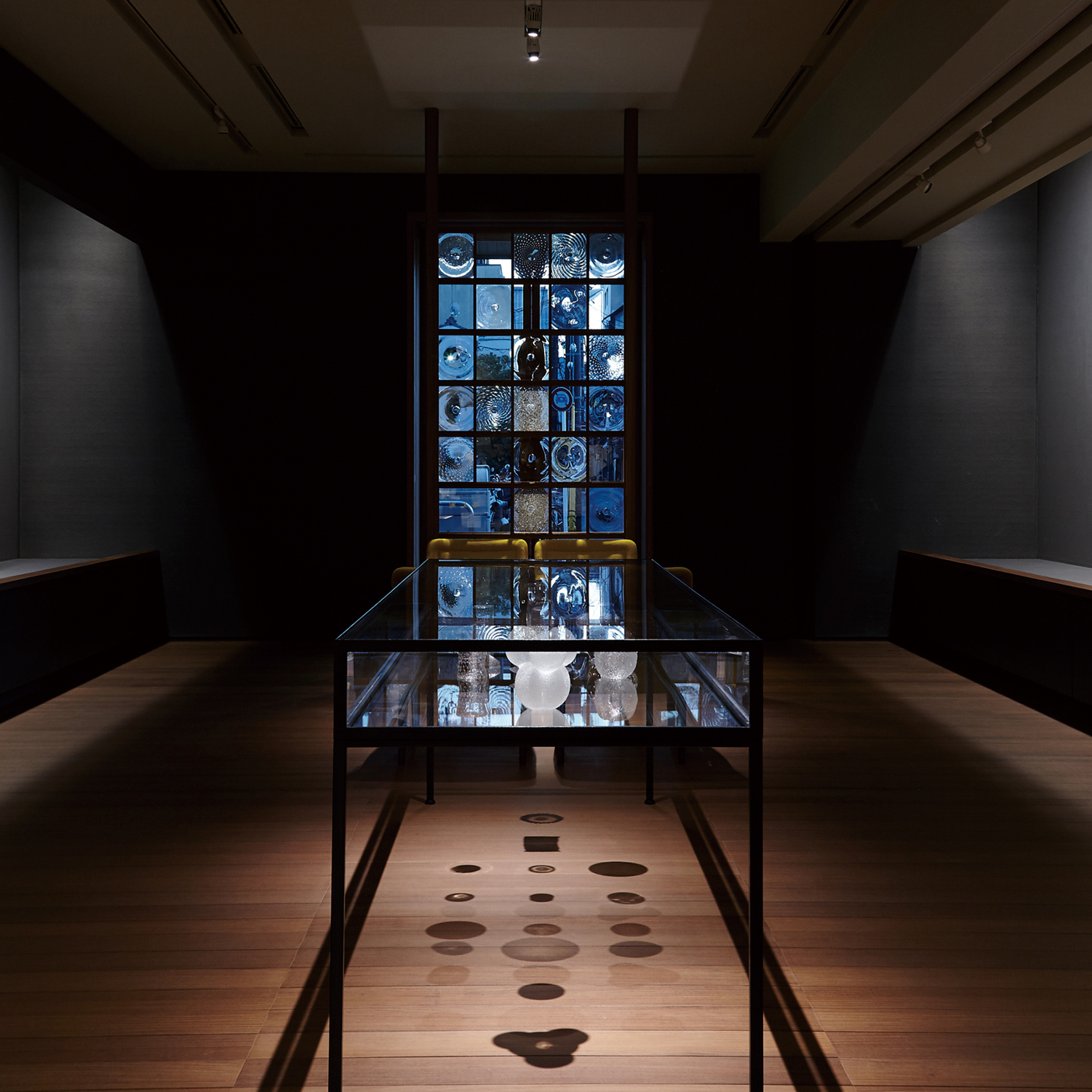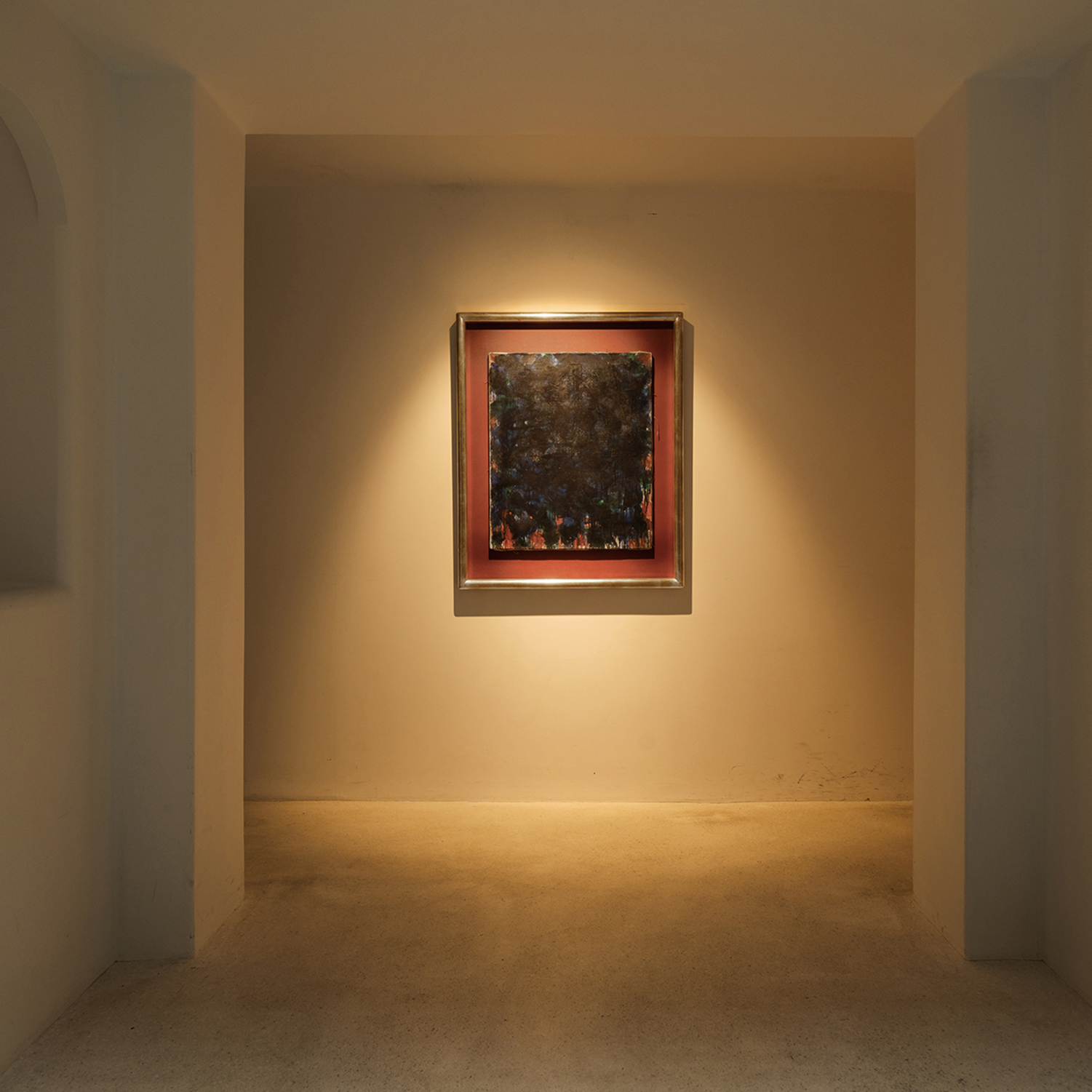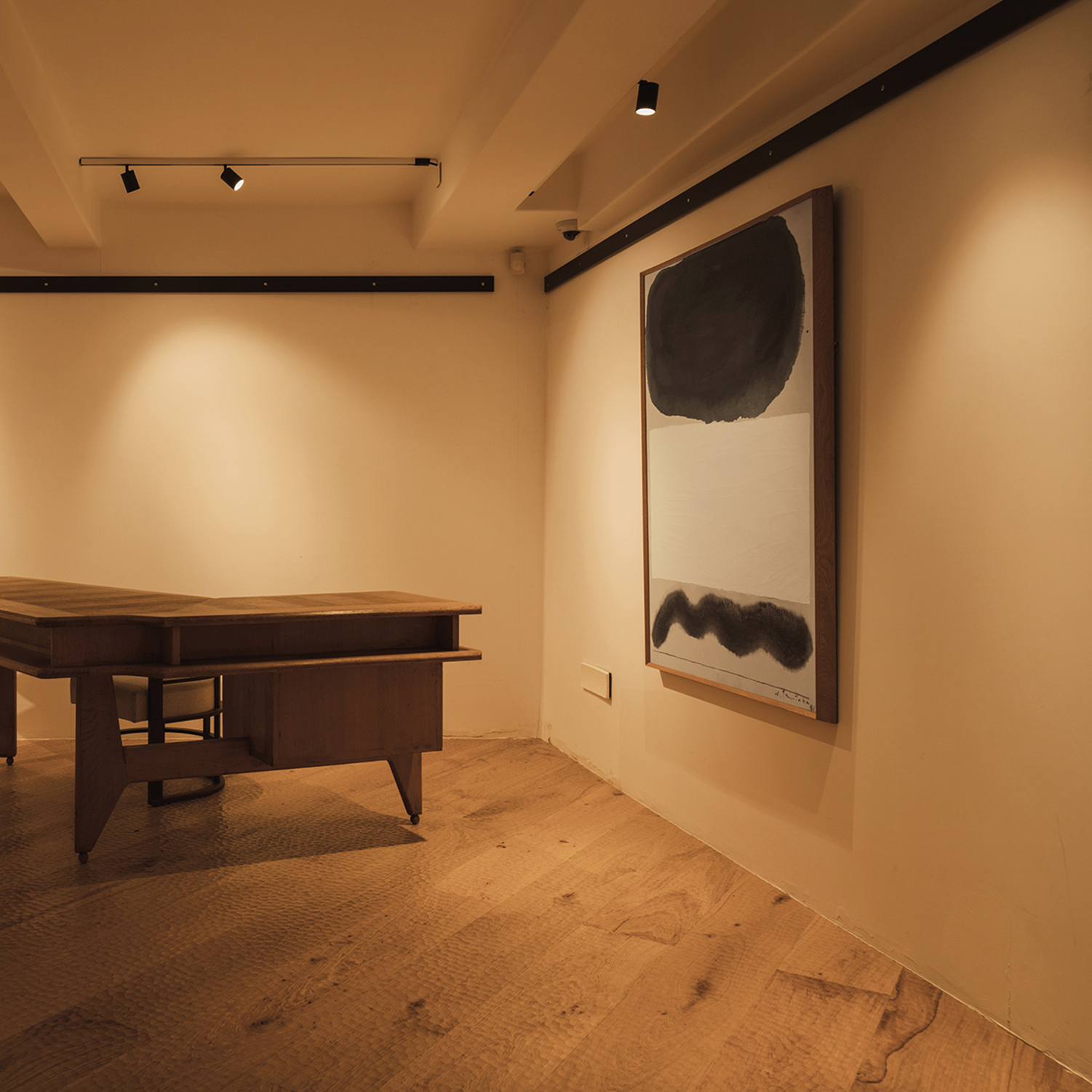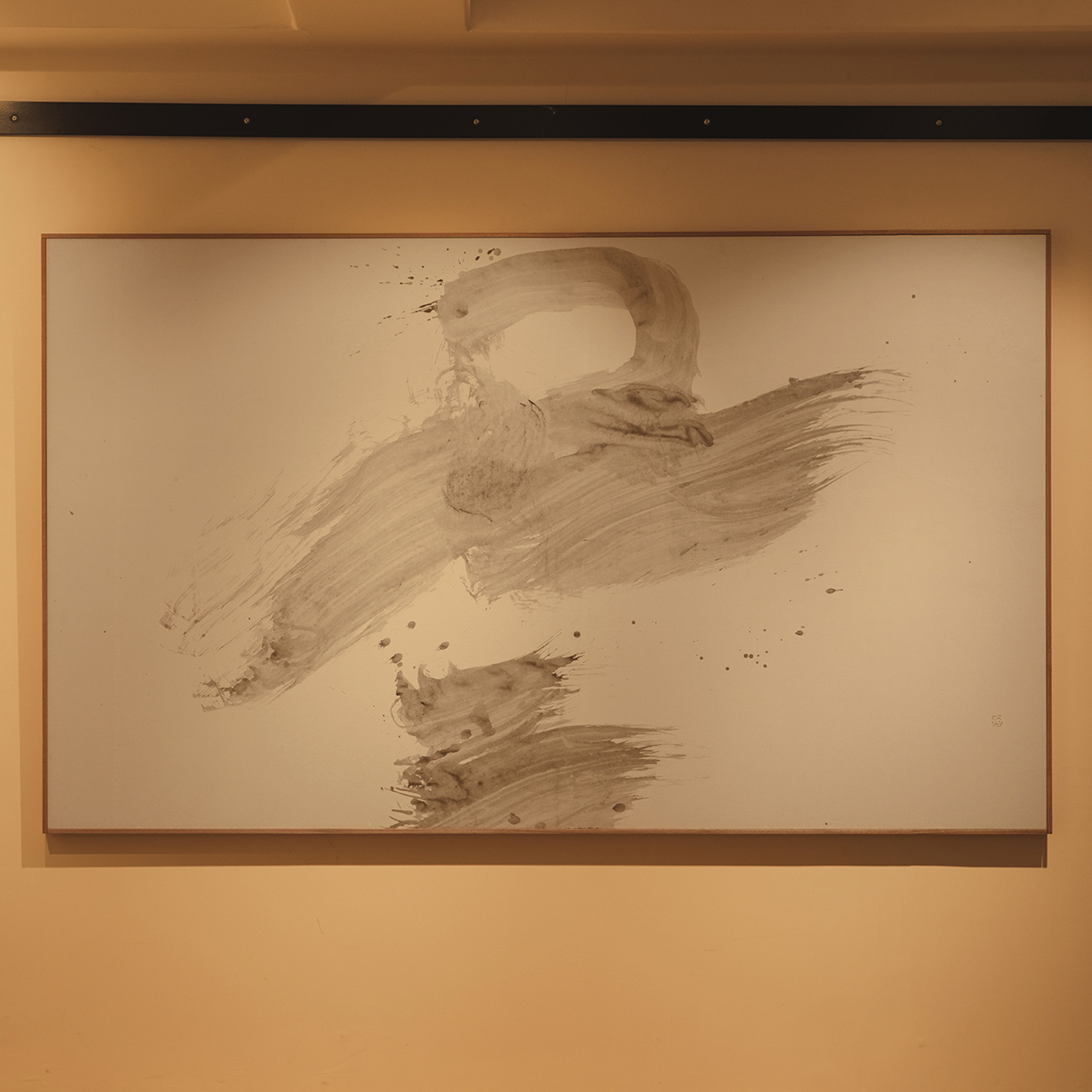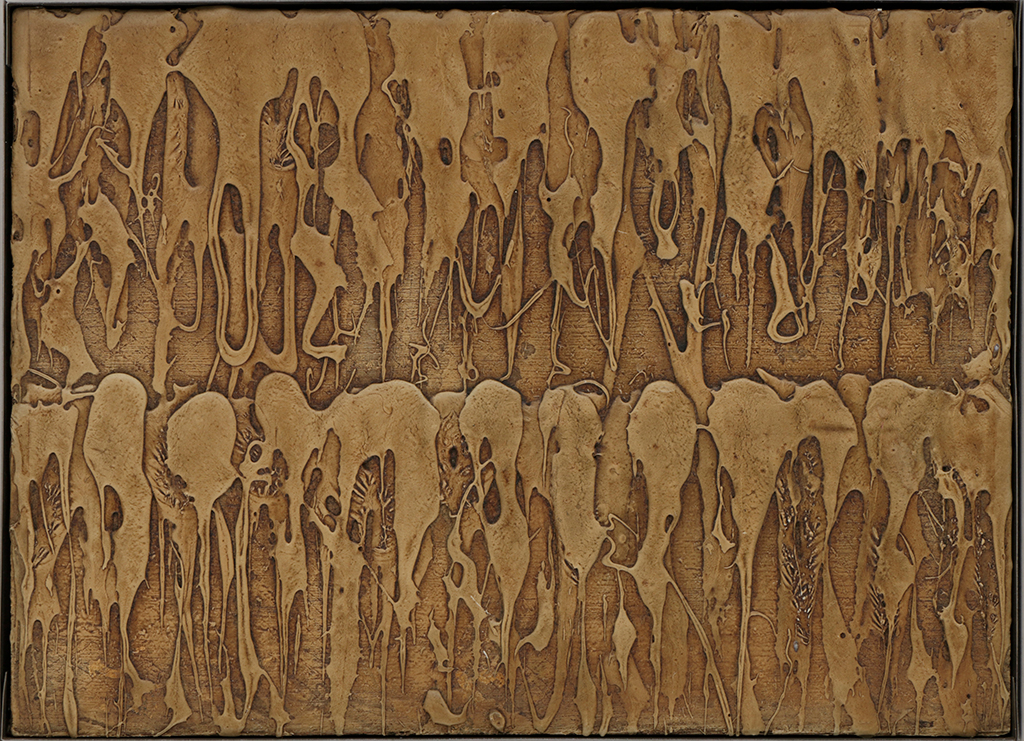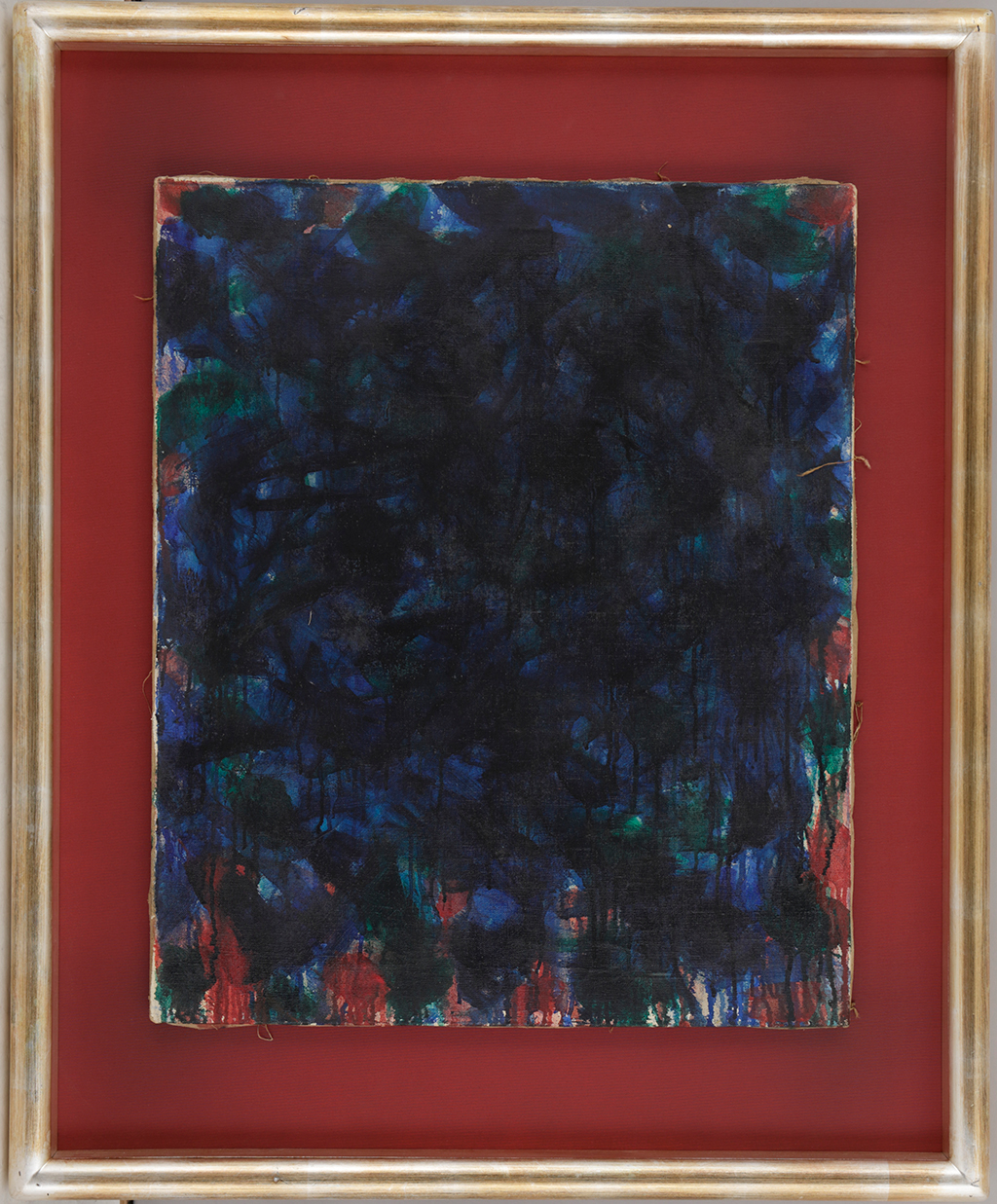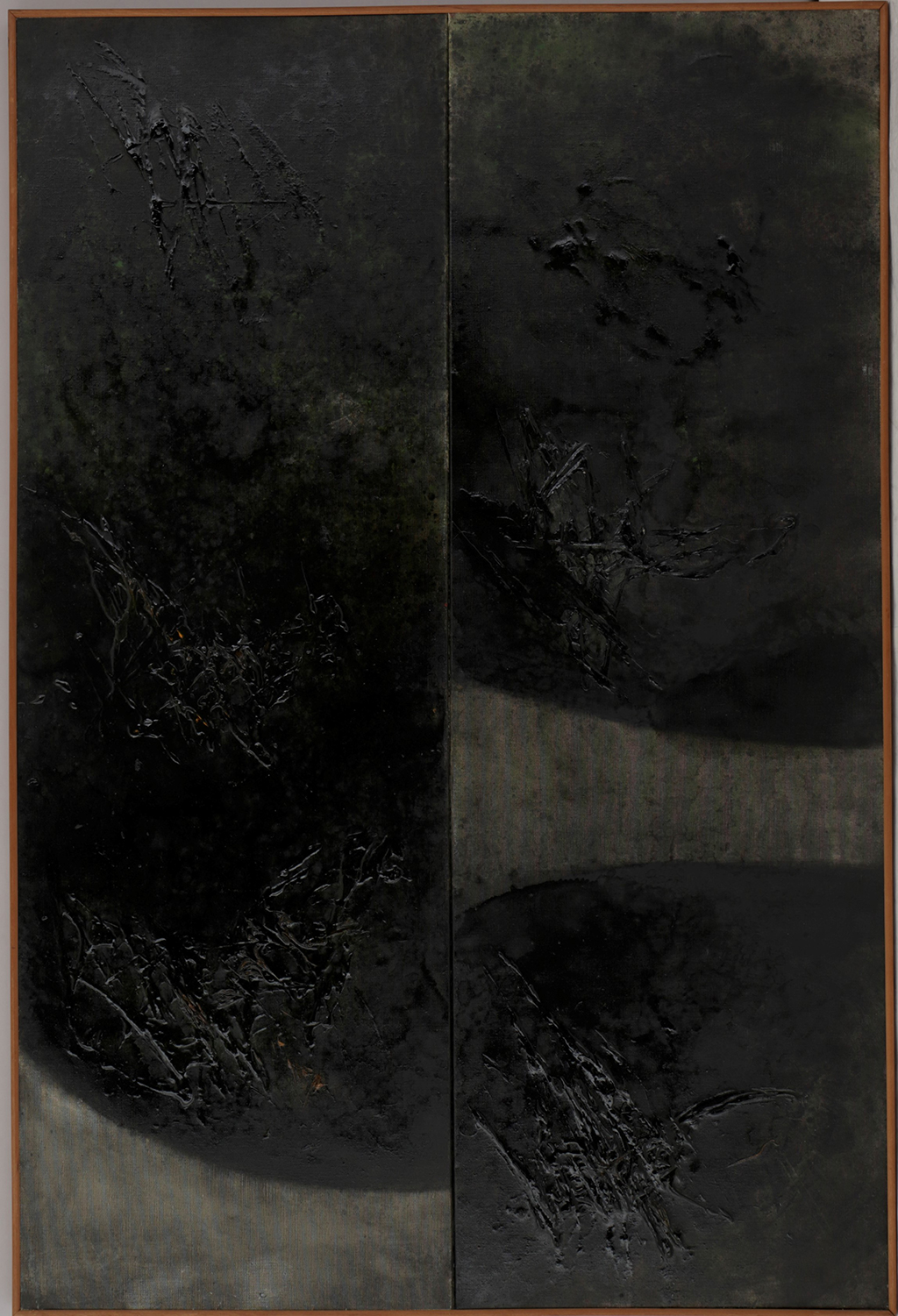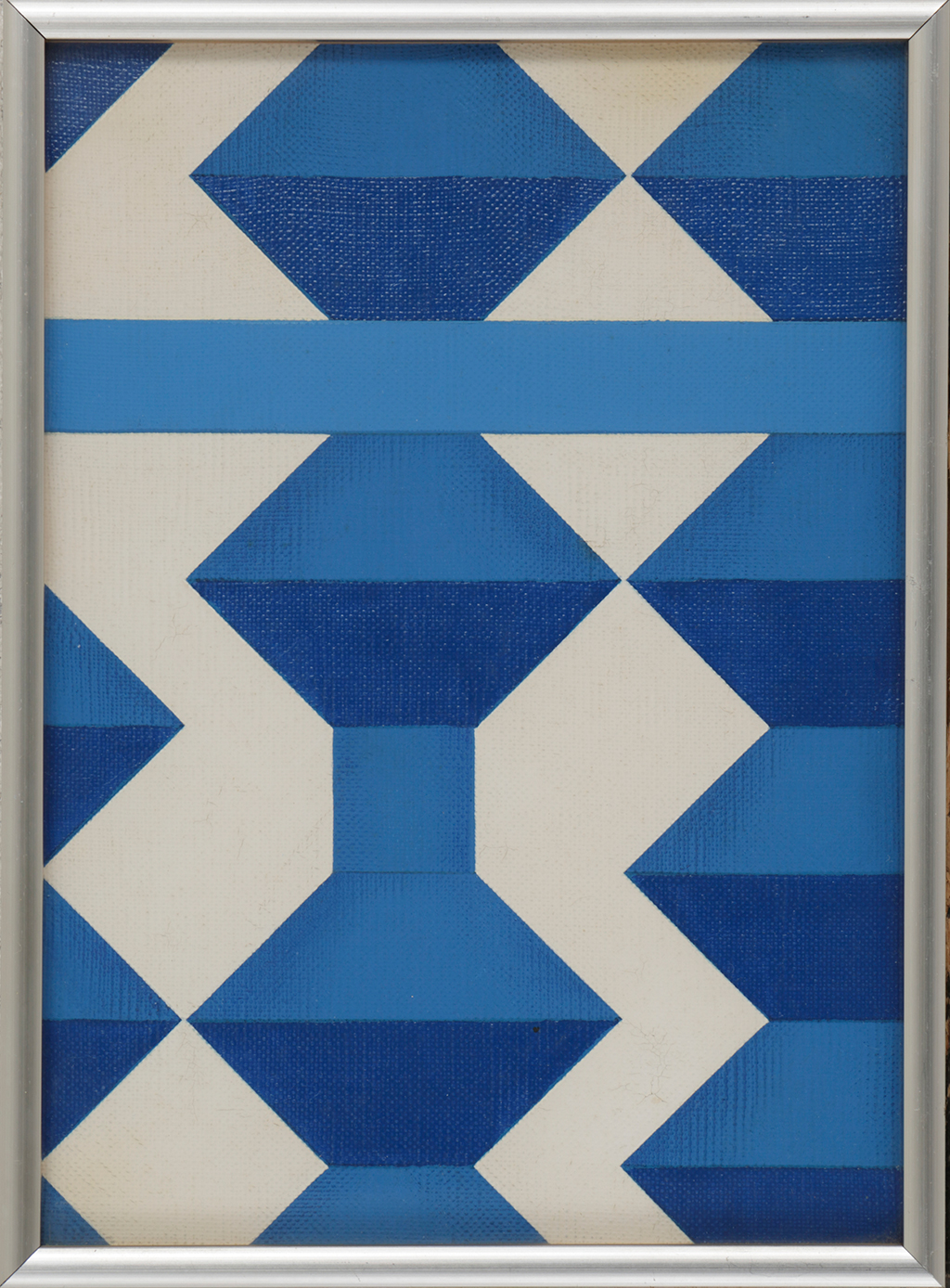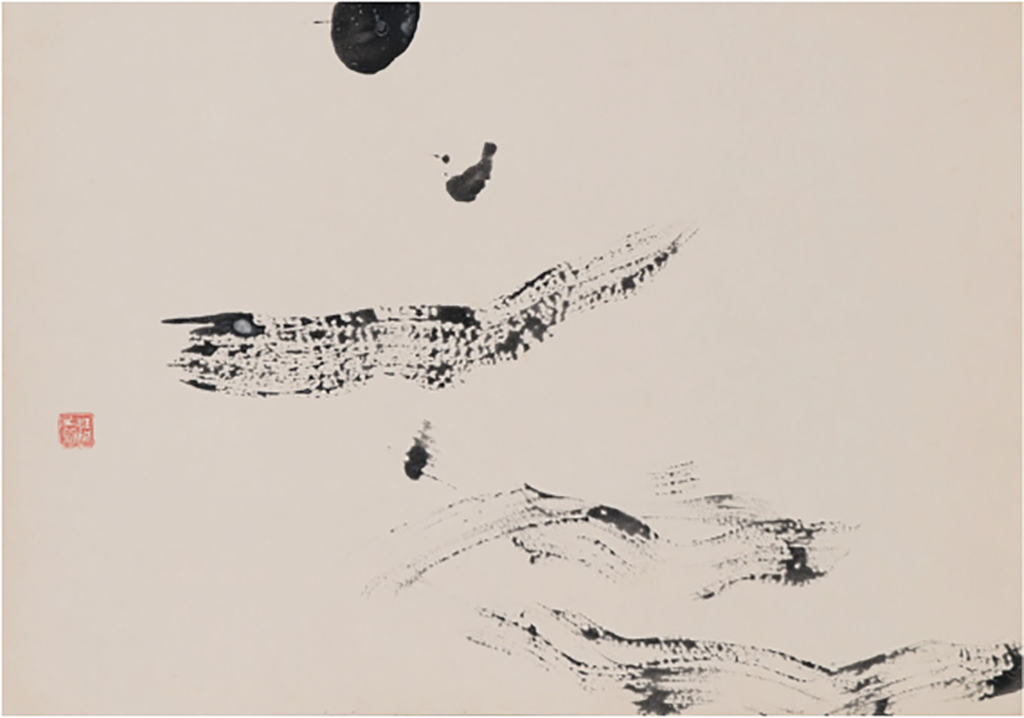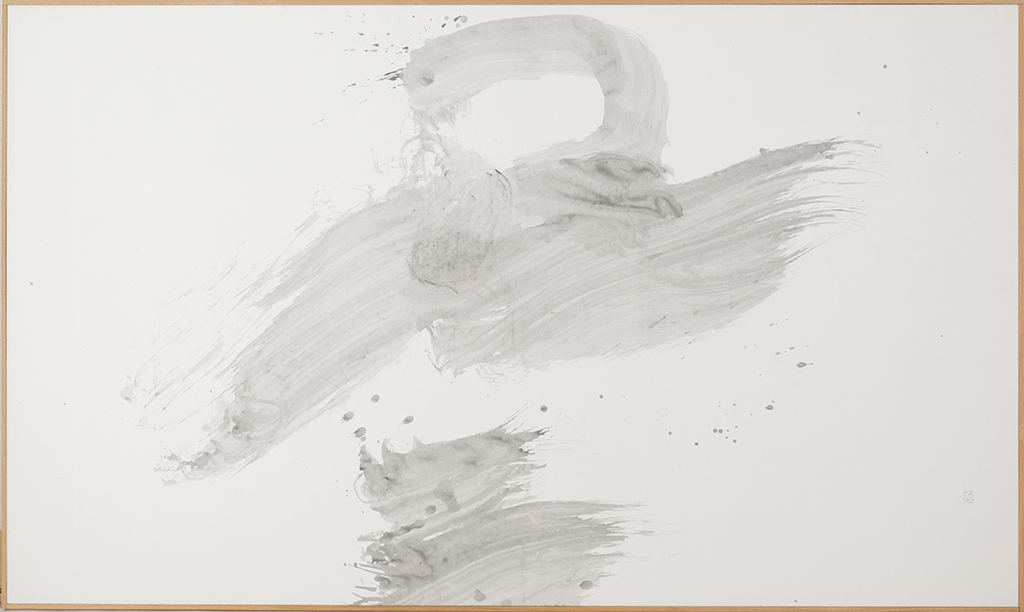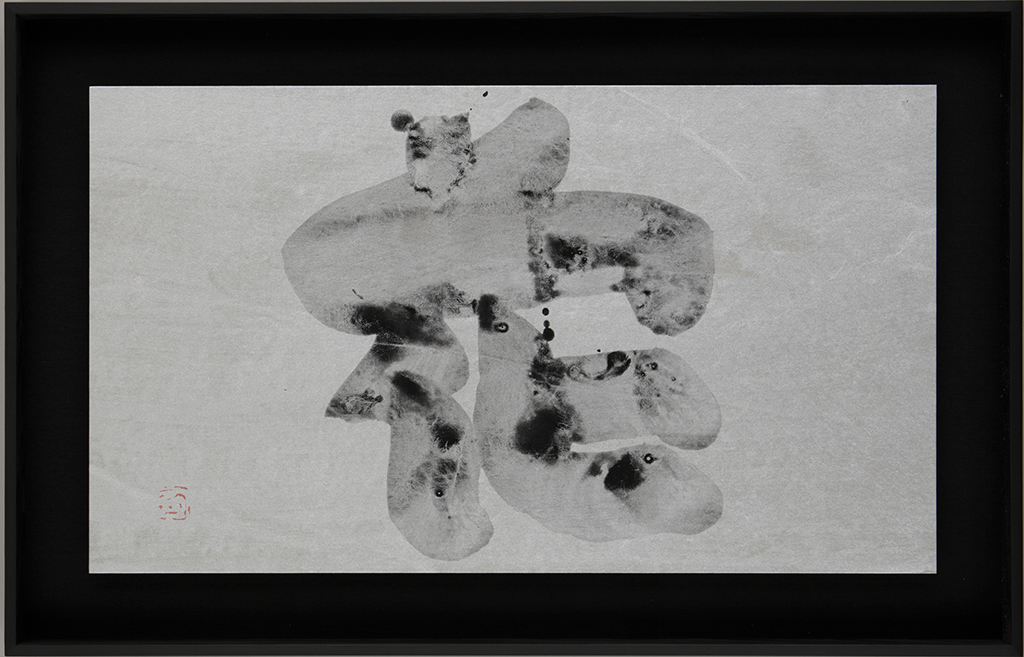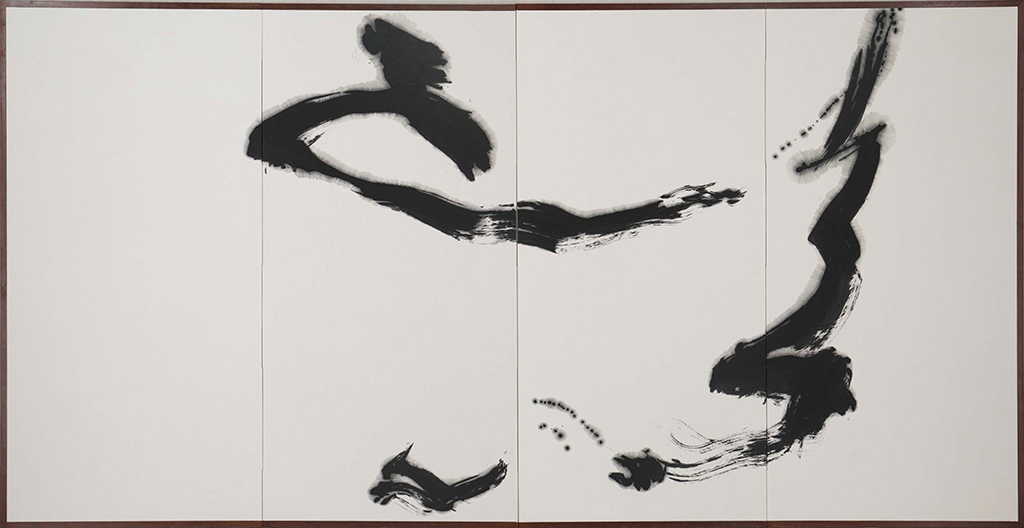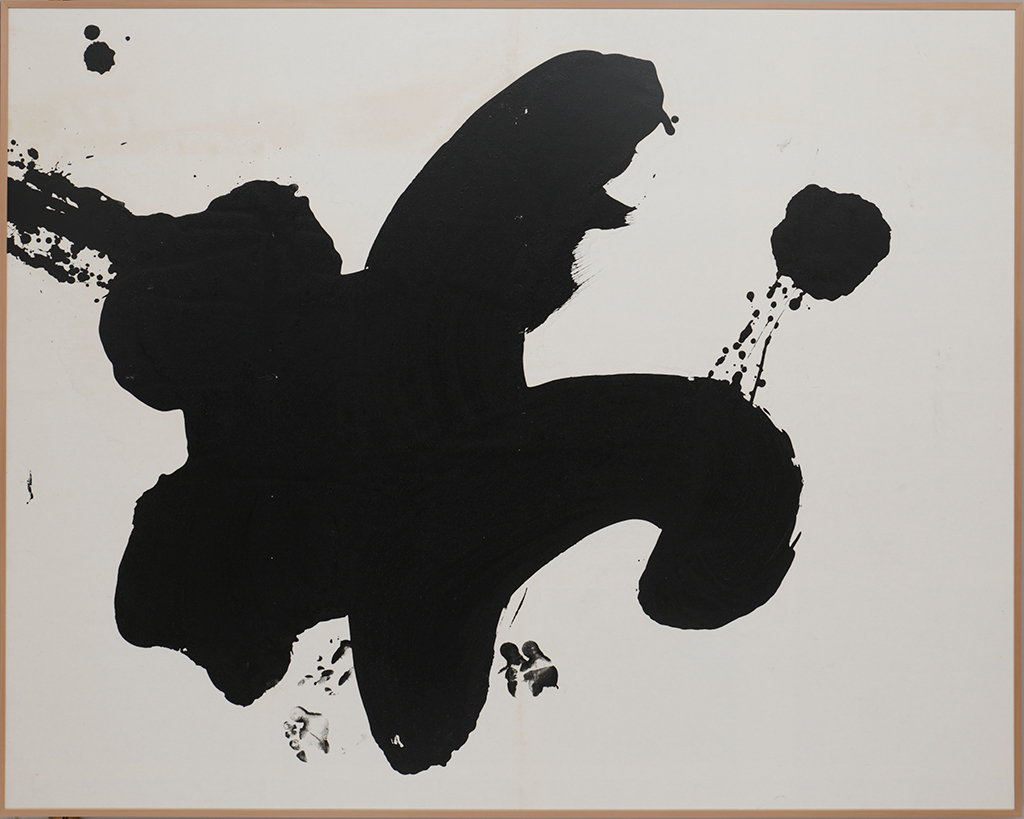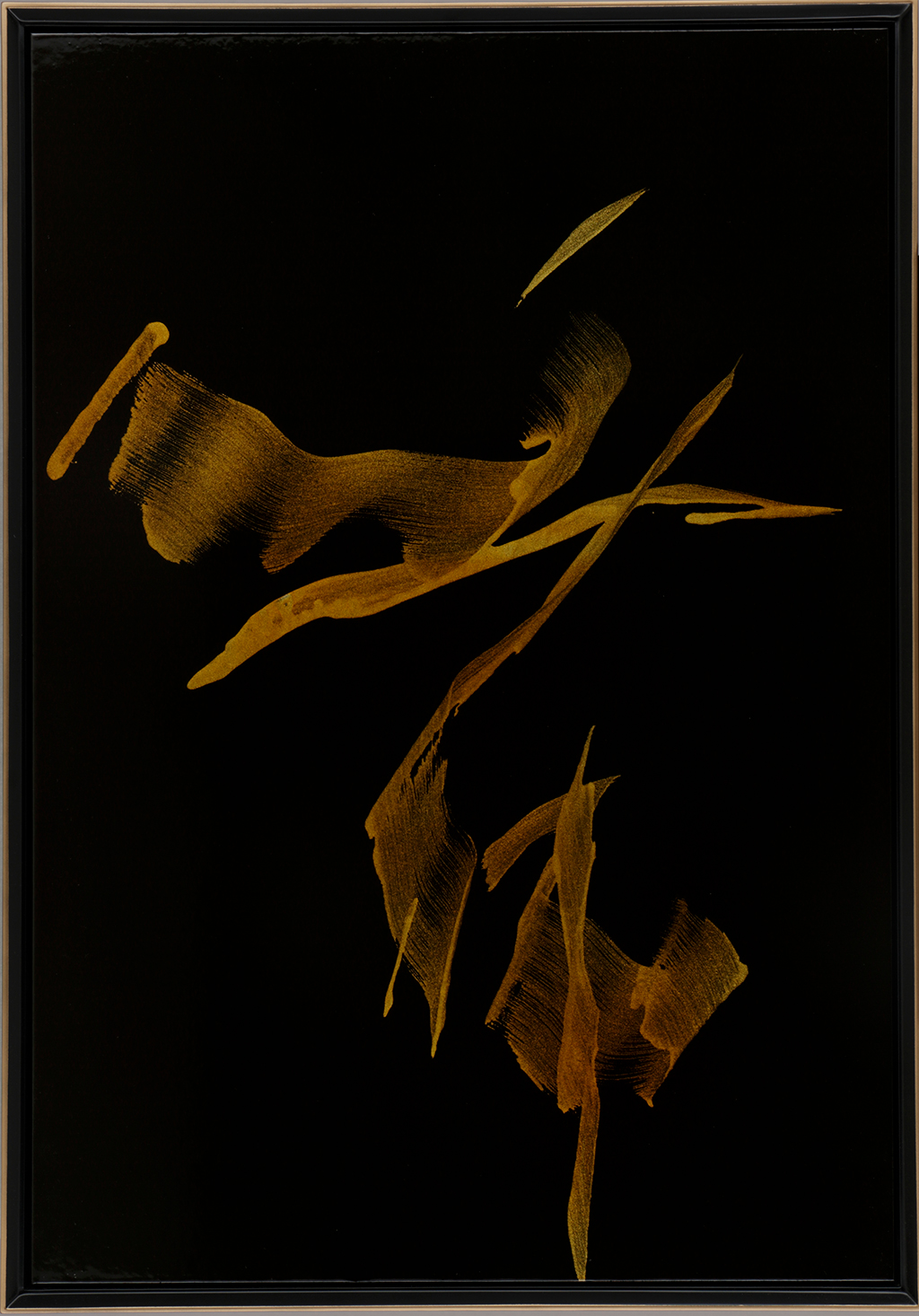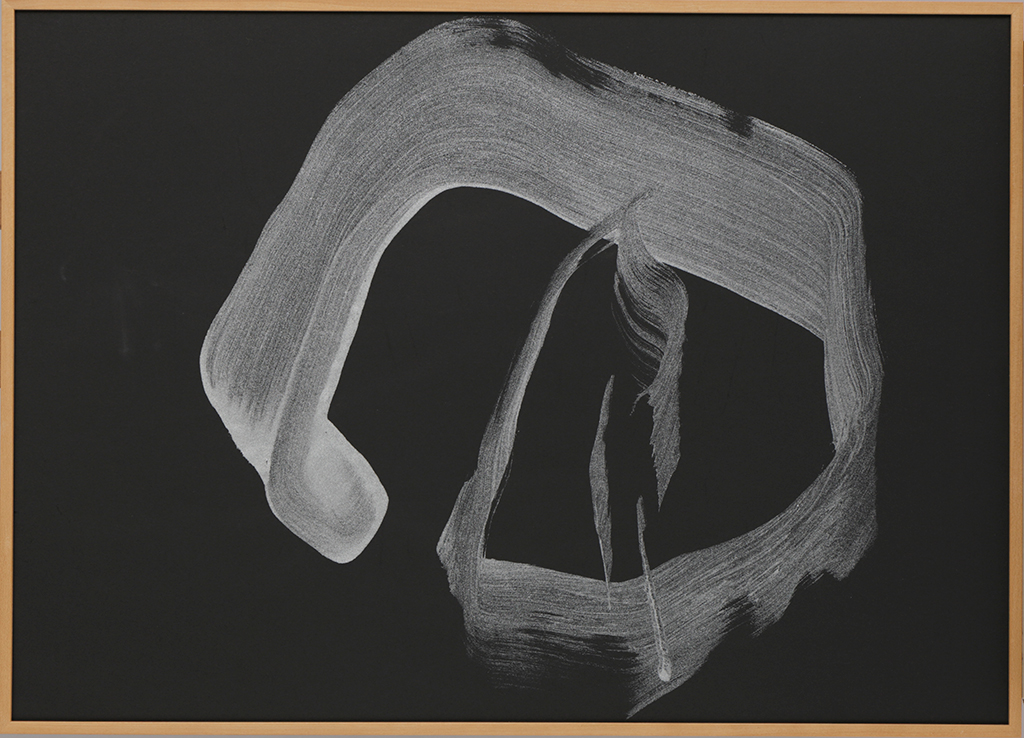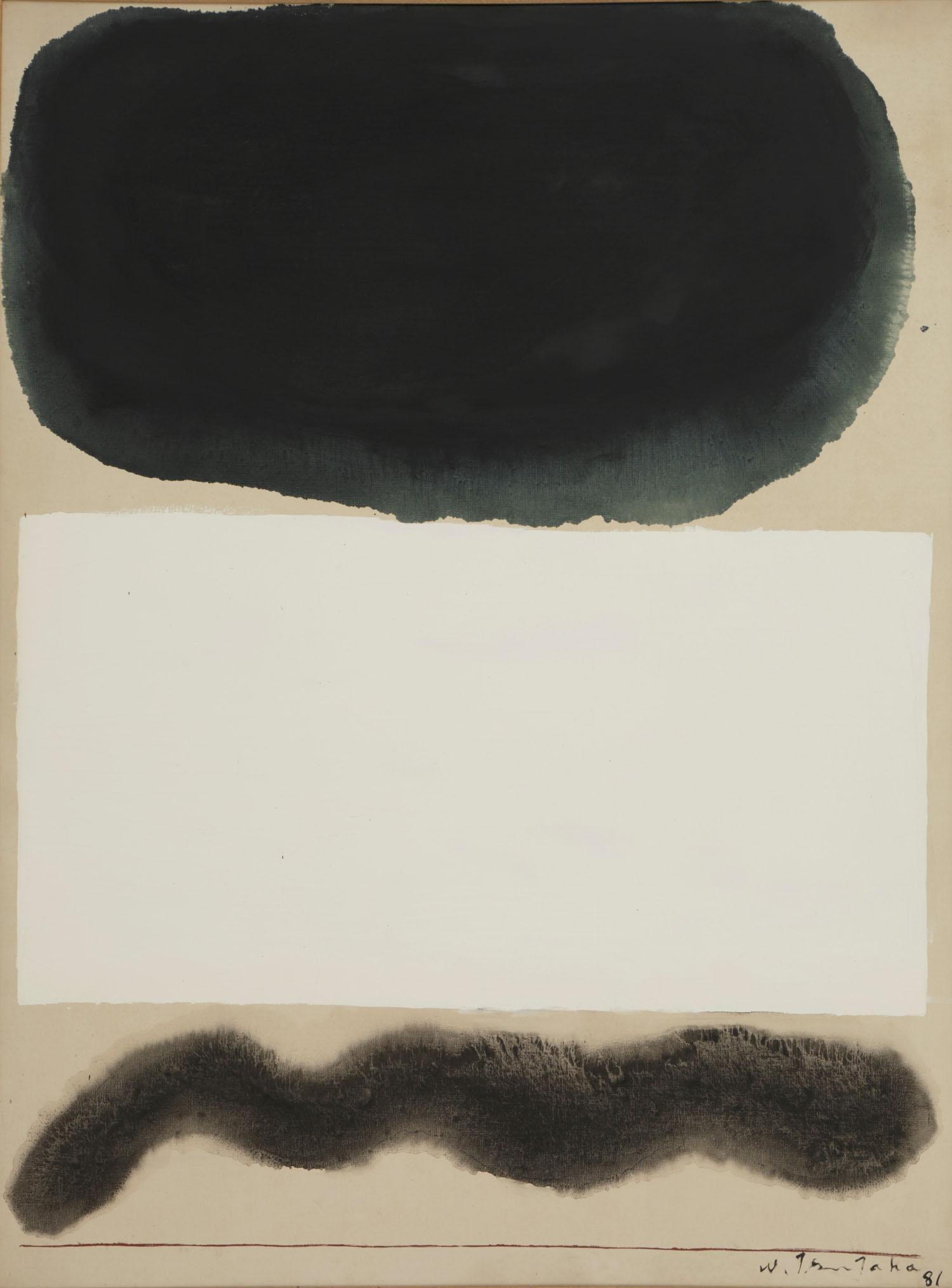

Tsutaka Waichi
1911-1995
Cosmos F
1981
Oil on canvas, framed
Dated and signed on the front
128 x 96 cm
Painter from Osaka. Tsutaka was enthusiastic about literature since his teens, issuing the private magazine Katachi (“Form”) and acting as a co-editor of Kobe Poets. He studied painting under Nabei Katsuyuki at Nakanoshima Western Art Institute. After the war, he co-founded Variety Art Association with Suda Kokuta and participated in the exhibitions of Kōdō (“Action”) Art Association and Genbi. Tsutaka was active nationally and internationally with numerous group and solo exhibitions including in Europe, the United States and South America. He was appointed a honorary professor at Osaka University of Arts.
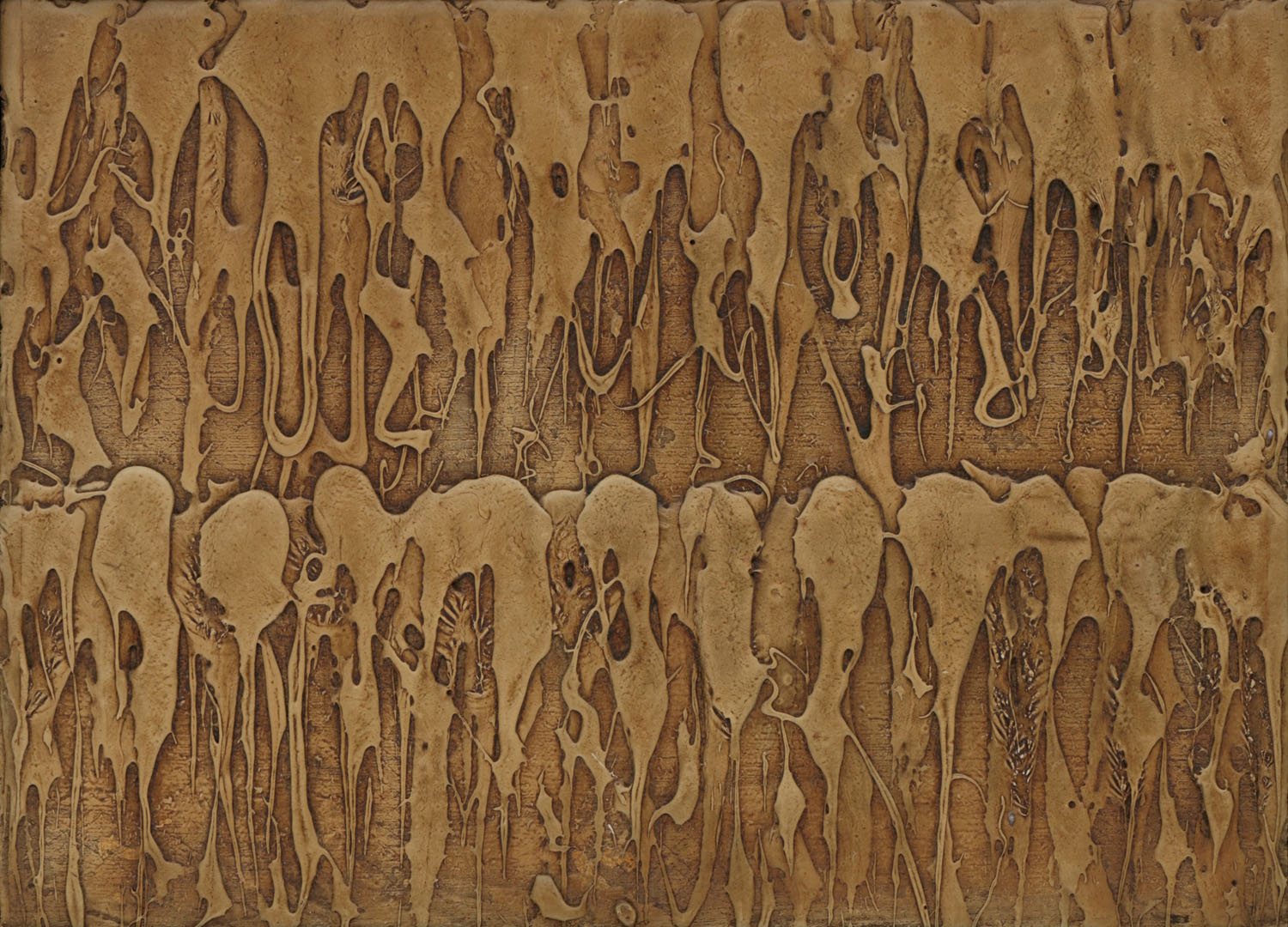
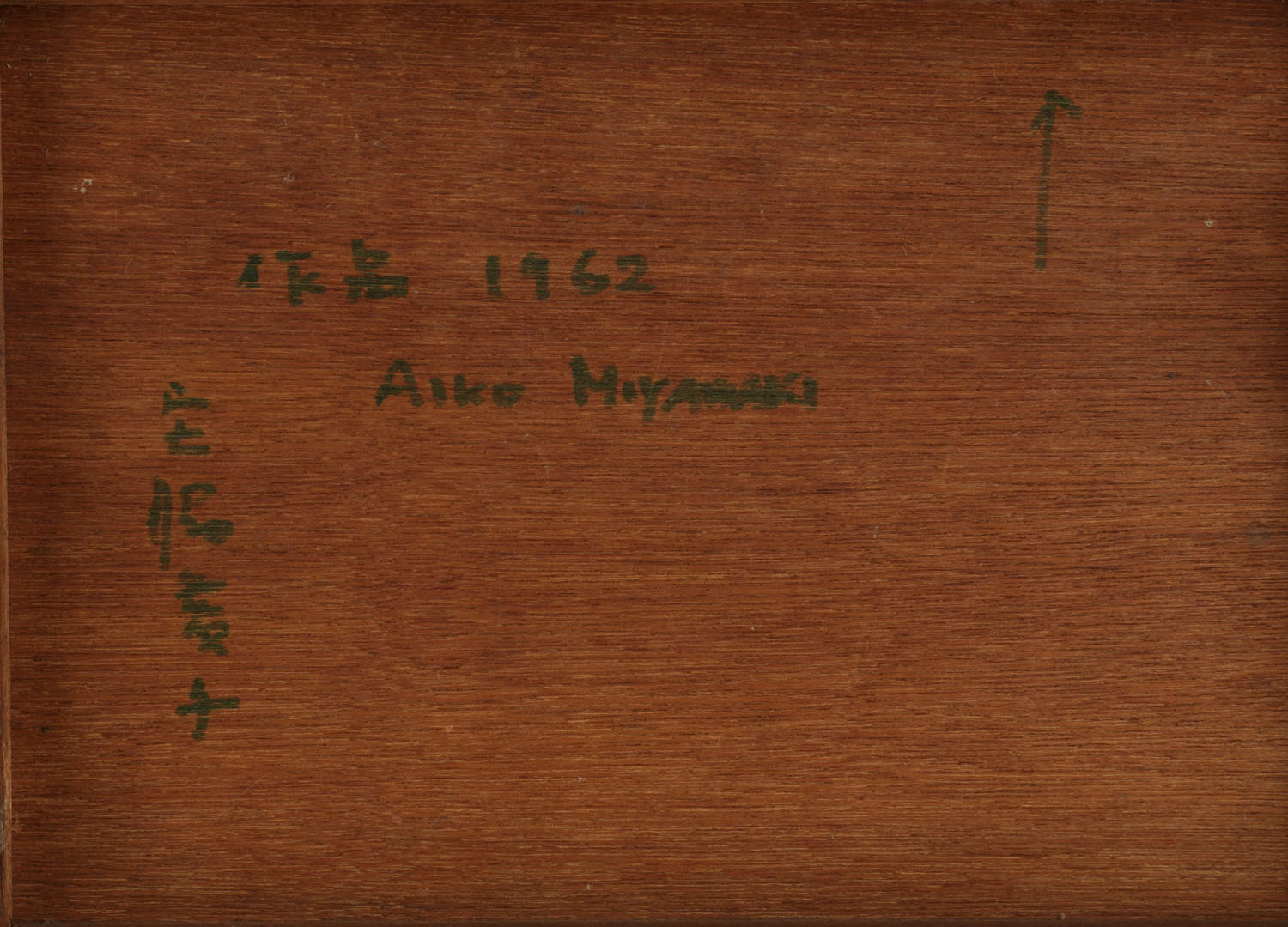
Miyawaki Aiko
1929-2014
Work
1962
Oil and marble powder on board, framed
Dated and signed on the reverse
24.2 x 33.4 cm
Sculptor and painter from Tokyo. Miyawaki graduated with a major in history from the Japan Woman’s University and continued to study fine art under Abe Nobuya (painter) and Saitō Yoshishige (sculptor and painter) at Bunka Gakuin, Tokyo. She later relocated temporarily to the United States and exhibited widely on an international stage, including in Milan, Paris, and New York. From the 1960s onwards, Miyawaki concentrated on three-dimensional works, making extensive use of materials such as metal and glass.
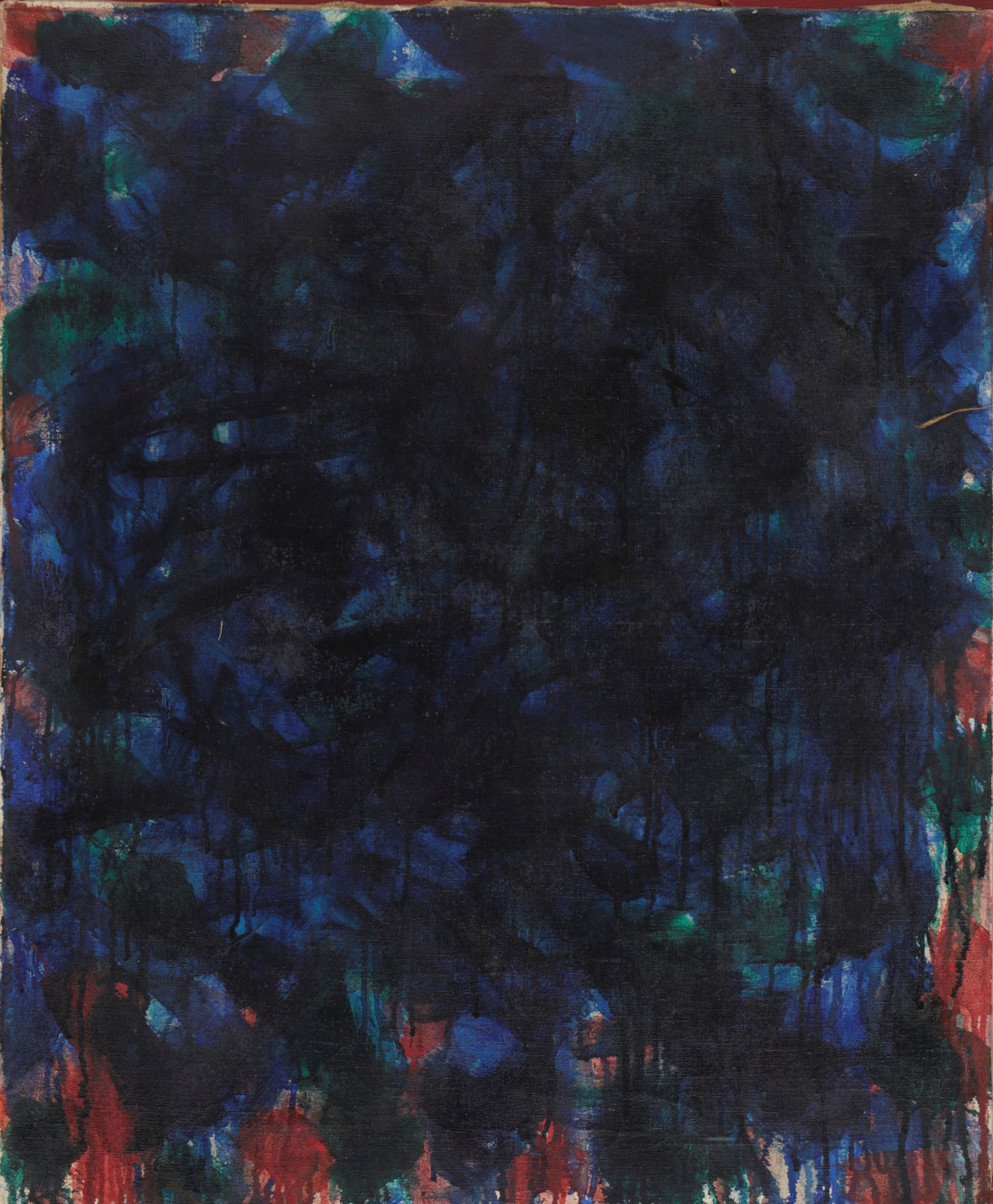
Imaï Toshimitsu
1928-2002
Norman Bluhm Blue #3
1955
Oil on canvas, framed
Titled, dated, and signed on the reverse
73 x 61 cm
Painter from Kyoto. Imaï learned painting from an early age at Asahi Kodomo Athene School. After his move to Tokyo, he studied with Ogi Tarō, Umehara Ryūsaburō and Yasui Sōtarō. In 1952, he moved to France and joined the Art Informel movement, splitting his time between France and Japan and exhibiting widely in Europe, the Americas and Japan. Around 1960, he moved away from his large-scale, dynamic paintings to concentrate more on the revival of traditional Japanese themes and artistic forms.
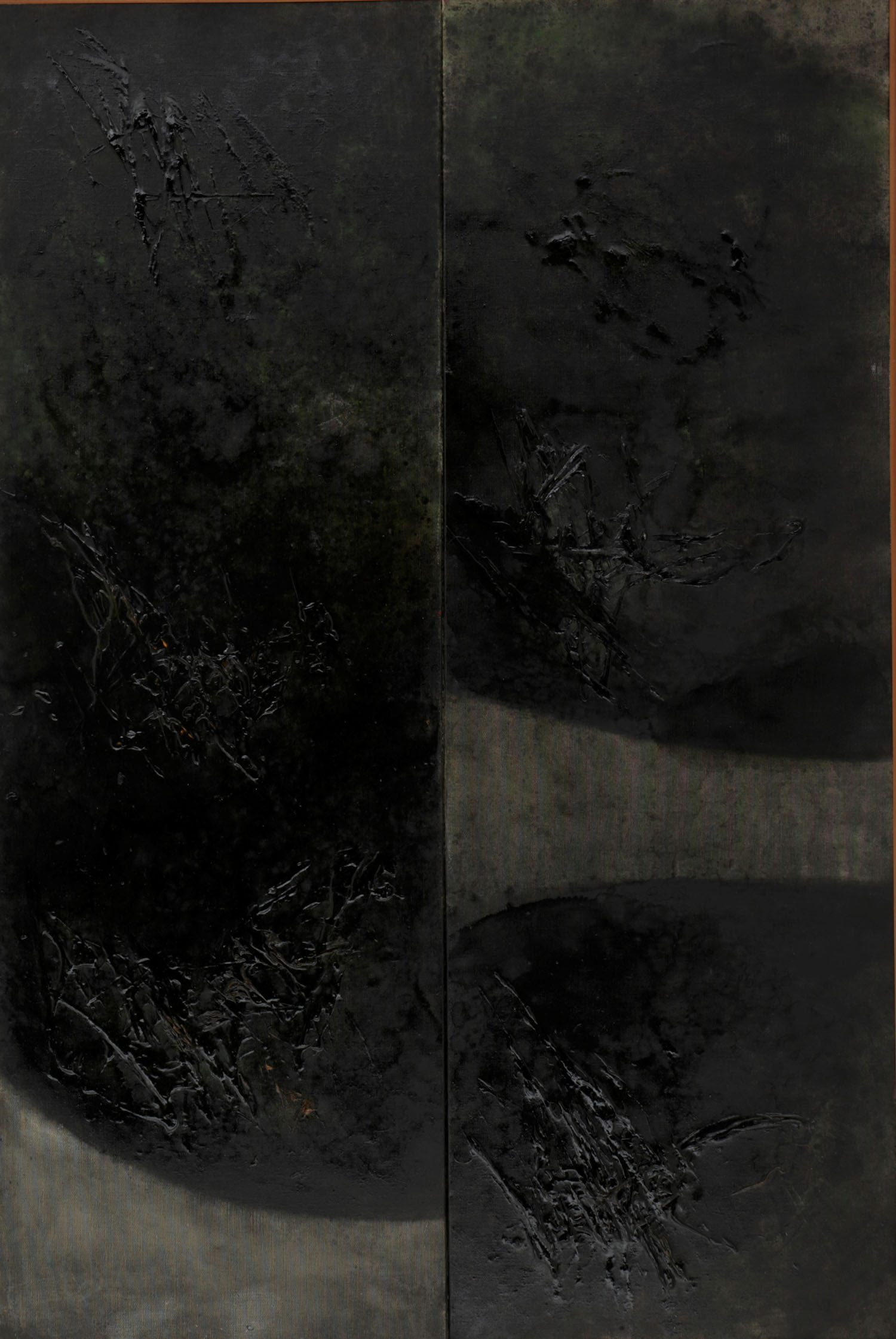
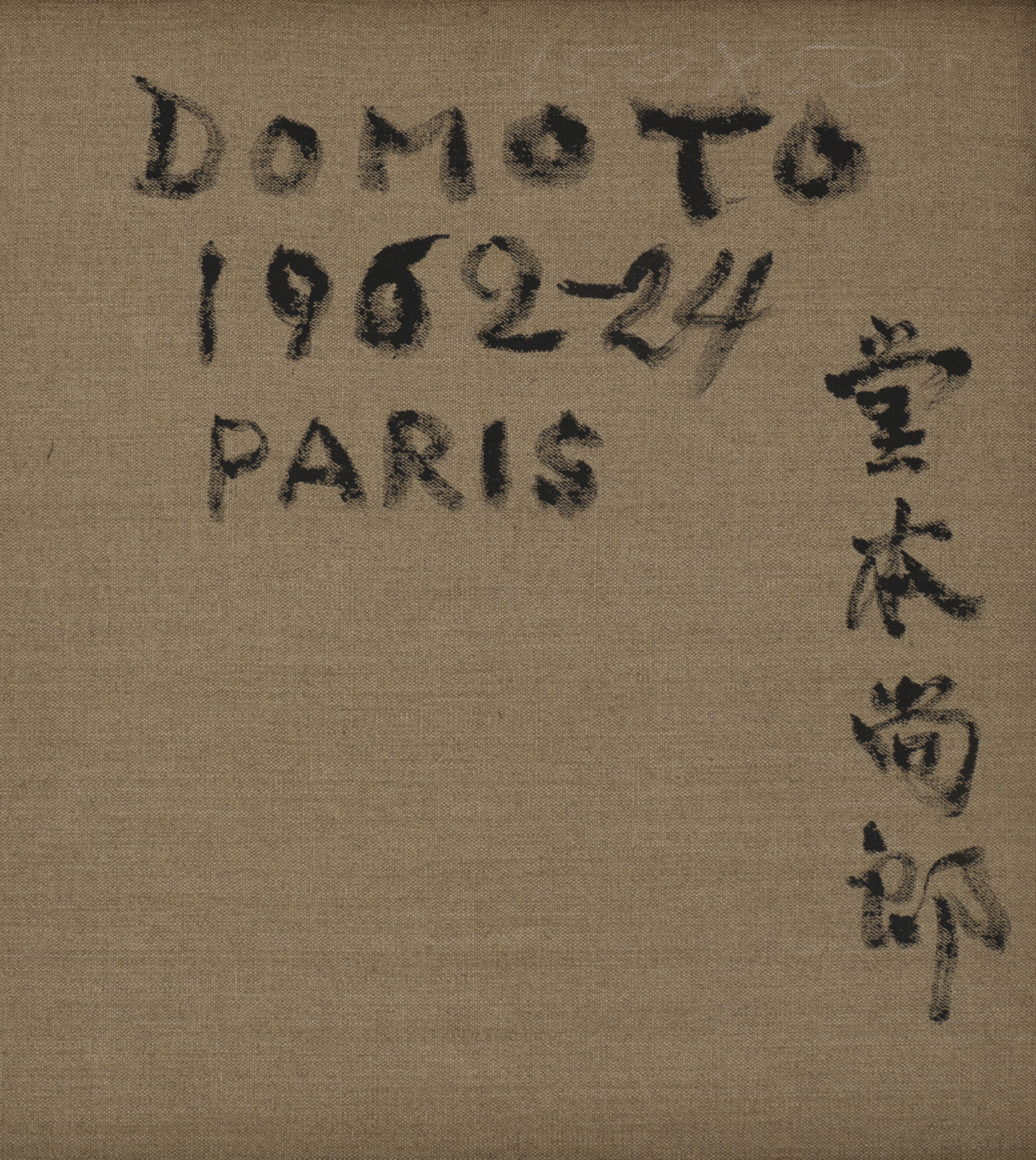
Dōmoto Hisao
1928-2013
1962-24
1962
Oil on canvas, framed
Titled, dated and signed on the reverse
149.5 x 99.8 cm
Painter from Kyoto; nephew of nihonga painter Dōmoto Inshō. Dōmoto studied at the Nihonga Department of Kyoto College of Art. After traveling to France together with his uncle, he decided to switch to oil painting. He moved to France in 1954, staying until 1965 while actively participating in various international art shows including the Venice Biennial. Dōmoto drew close to the Art Informel movement and especially Michel Tapié. He counts among Japan’s most prominent abstract postwar painter.
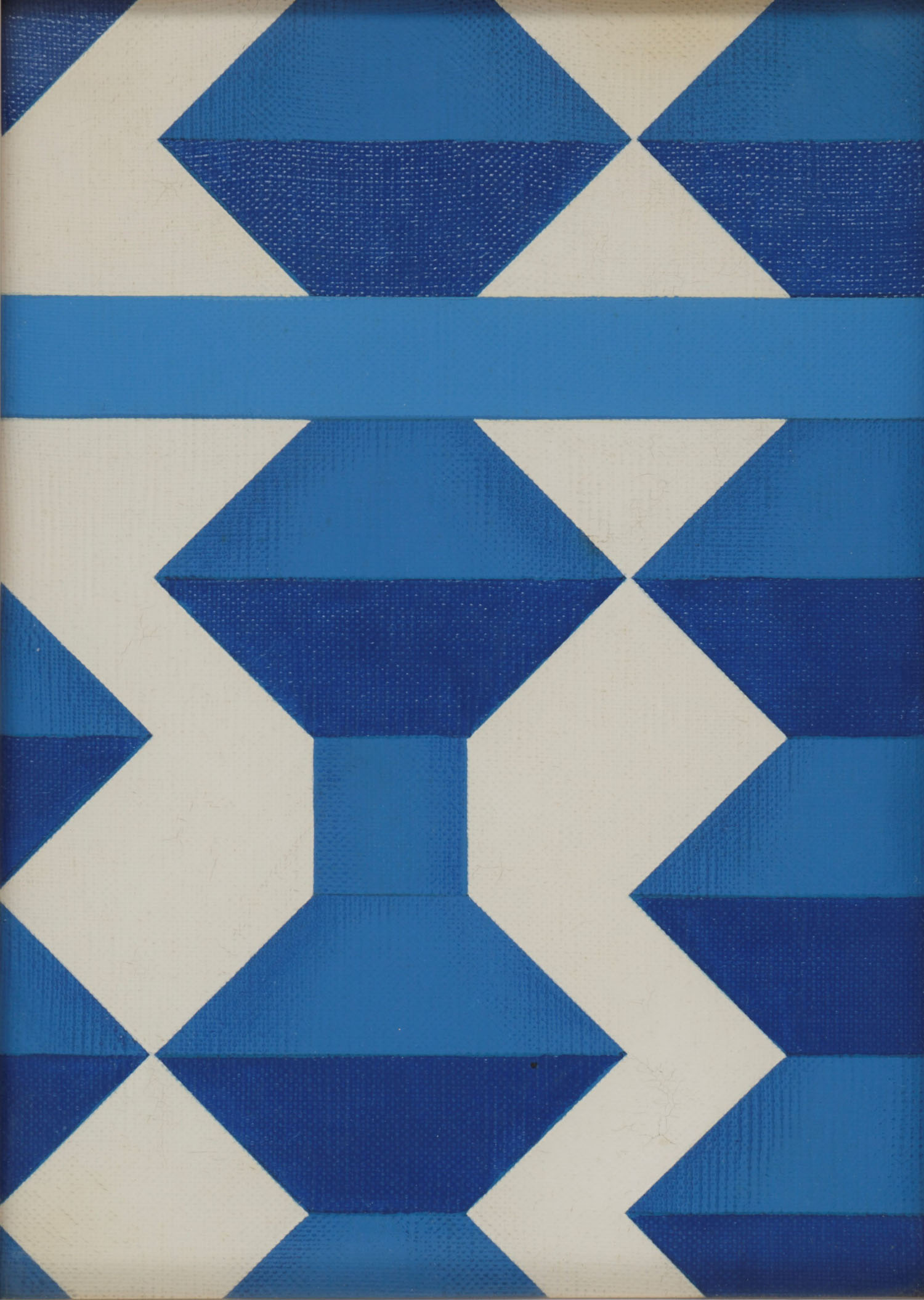
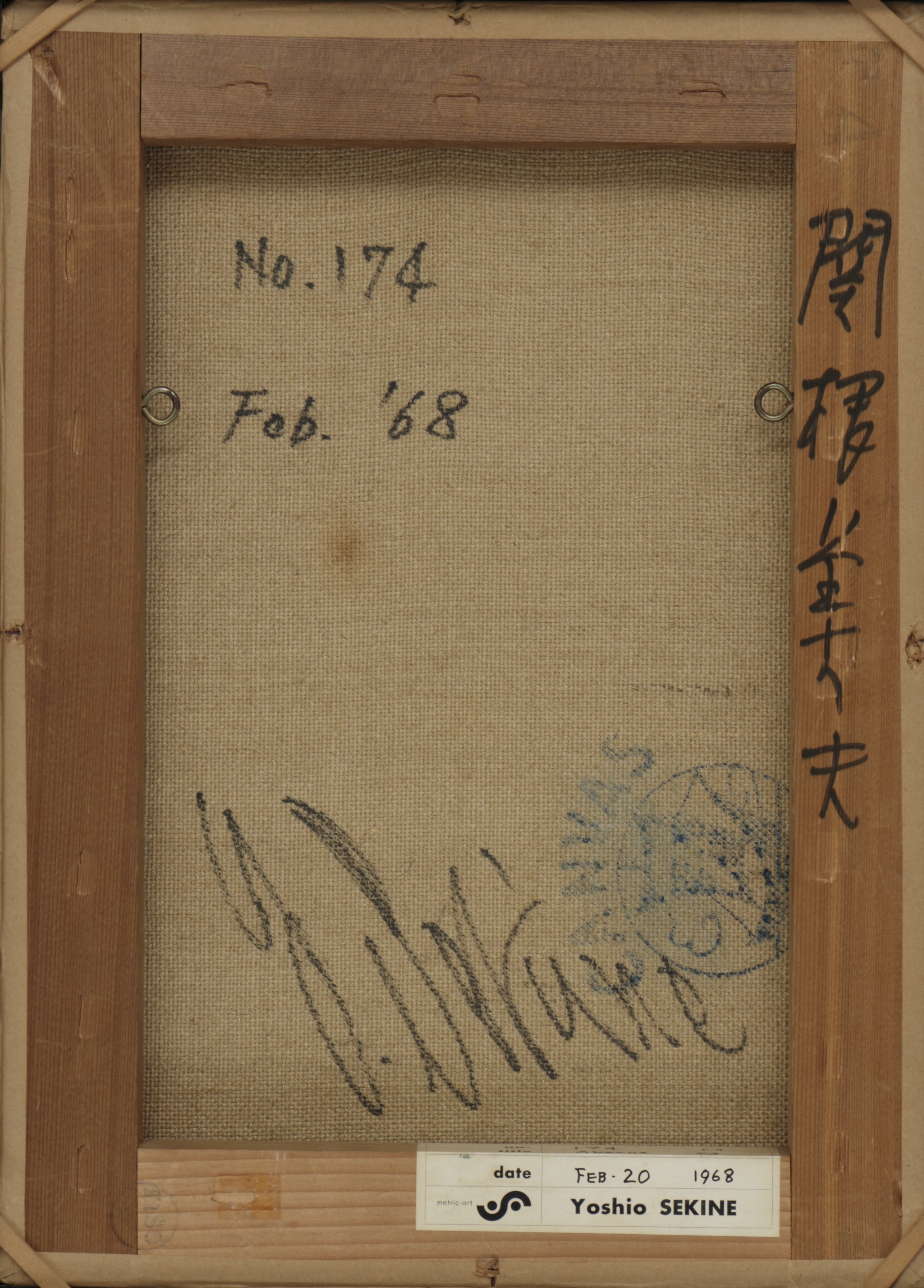
Sekine Yoshio
1922-1989
No. 174
1968
Oil on canvas, framed
Titled, dated, and signed on the reverse
33.5 x 24.4 cm
Painter from Wakayana prefecture. Sekine studied under Nakamura Makoto and later Yoshihara Jirō. He was the founding memberof the Gutai Art Association. He left Gutai in 1959, and began to strive for abstract representation of real life motifs. Sekine is well-known for his distinctive style, "a hybrid of representational and abstract art." His works were widely exhibited in Japan and abroad including the Japan Art Festival (1966, 1970) and many others.
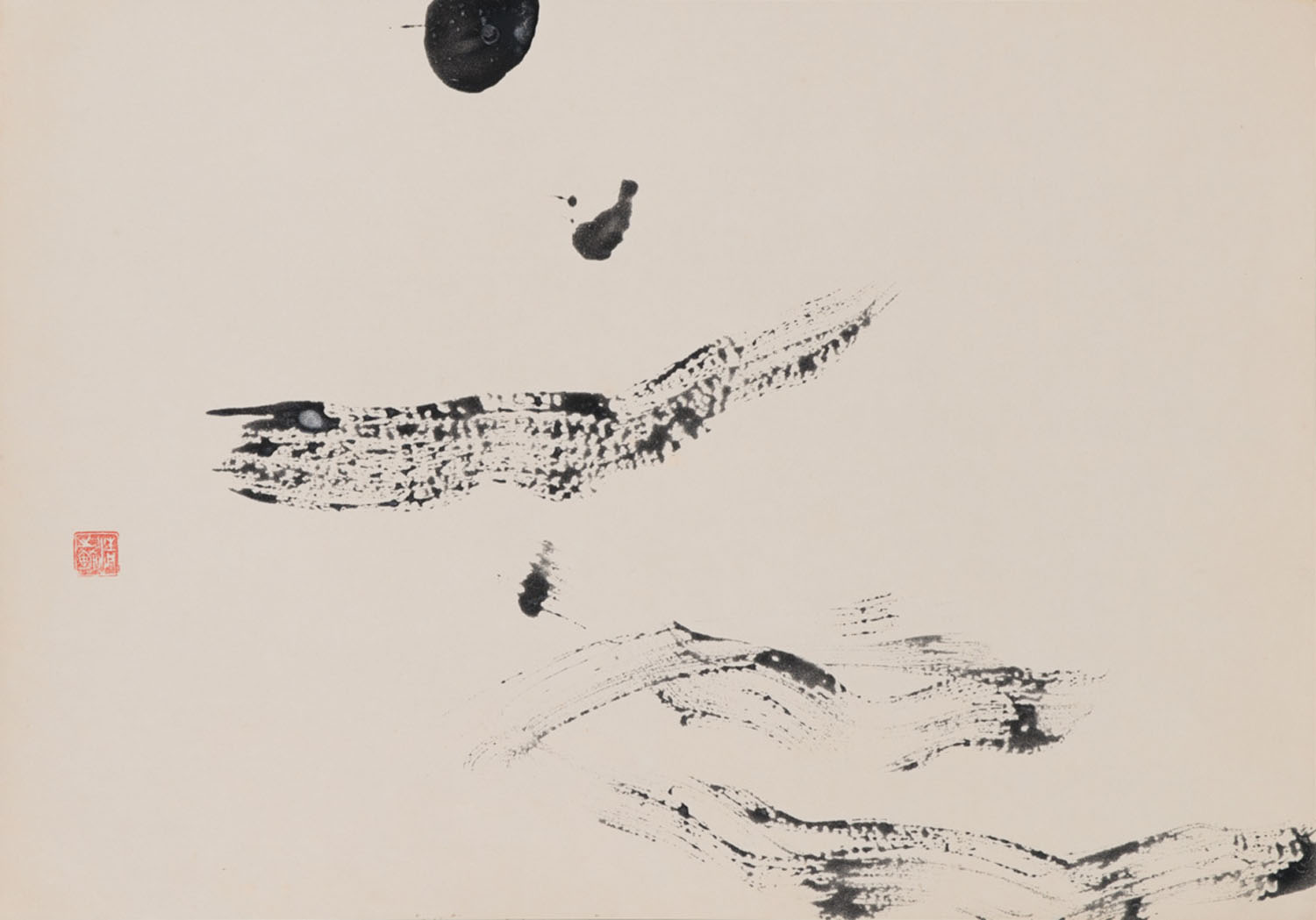

Morita Shiryū
1912-1998
Kan (return; return to the original source)
1963
Ink on paper, framed
Sealed ""Sei no ji"" on the left
With a label issued by Inada Sousai of
Bokujinkai and Soryusha
41.2 × 59 cm
Publication
Inada Sousai ed. Morita Shiryū Catalogue
Raisonné: 1952-1998. Uji, Kyoto:
Soryusha, 2019.
Catalogue Raisonné no. XVI-007
Avant-garde calligrapher from Hyōgo Prefecture. Like fellow artist Inoue Yūichi, Morita studied under the calligraphy master Ueda Sōkyū. He co-founded the avant-garde group Bokujinkai together with Inoue and was the founder and editor of the journal Bokubi (Beauty of Ink), both of which revolutionized traditional Japanese calligraphy and spread knowledge of Japanese avant-garde calligraphy to an international audience. He was posthumously awarded the Medal of Honor with Dark Blue Ribbon.
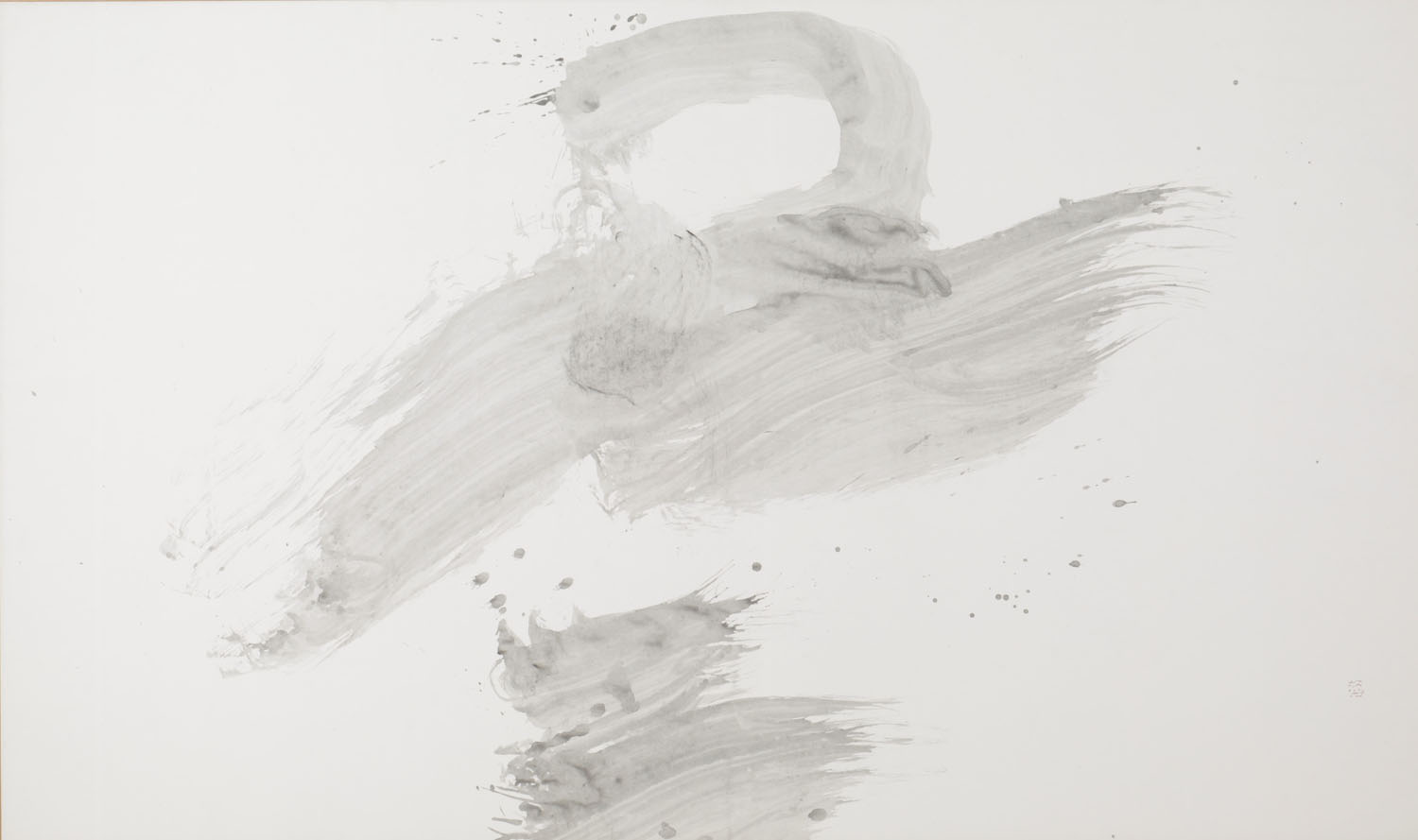
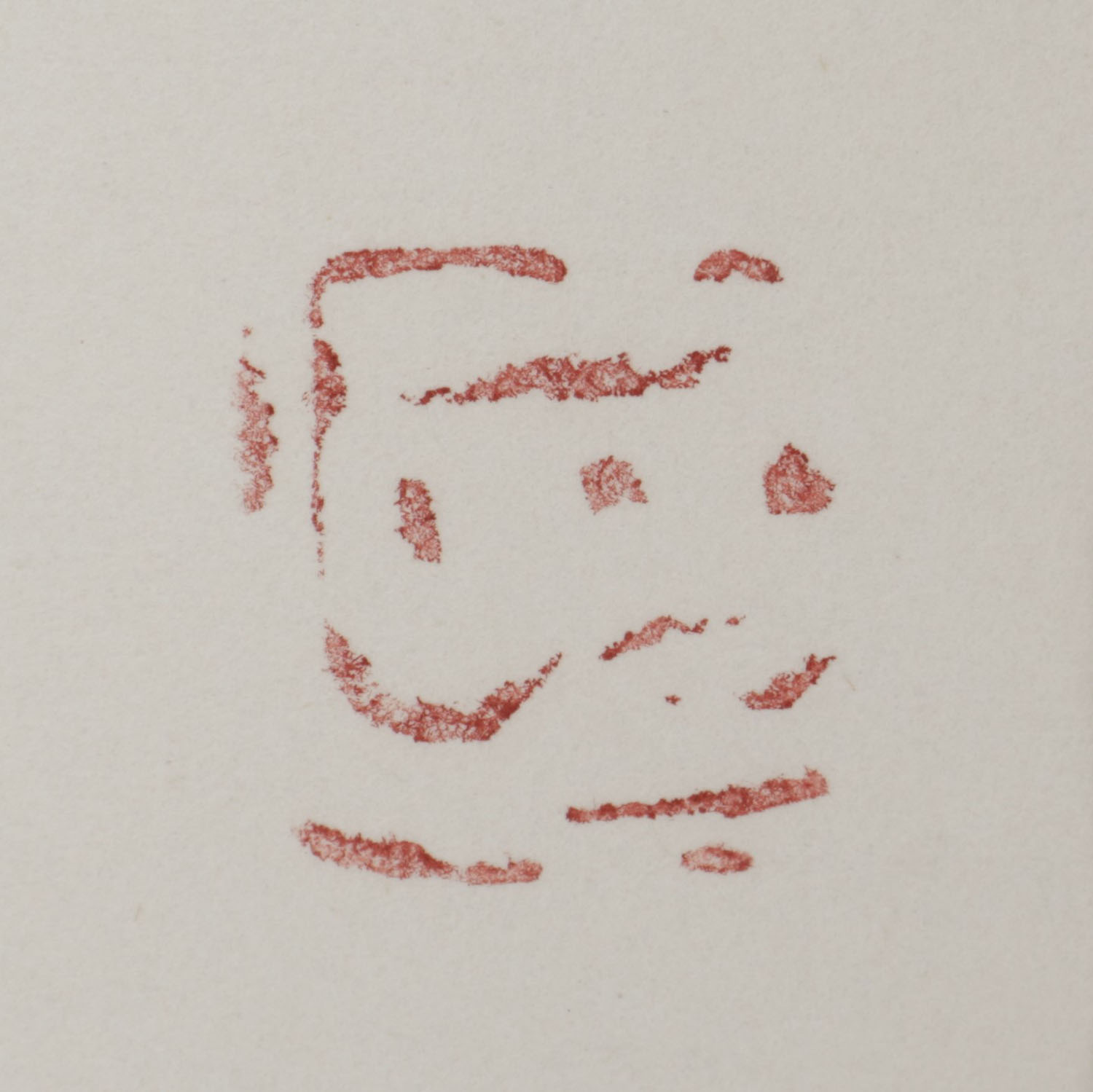
Inoue Yūichi
1916-1985
Jin (to come to an end, to use up completely)
1966
Ink on paper, framed
Sealed "yū" on the lower-right
124.5 × 210.5 cm
Publication
Unagami Masaomi
ed. Yu-ichi [Yu-ichi INOUE]:
Catalogue Raisonné of the Works
1949-1985. Vol. 1. Tokyo:
Unac Tokyo, 1998.
Catalogue raisonné no. 66125
Avant-garde calligrapher from Tokyo. Inoue studied calligraphy under Ueda Sōkyū, an avant-garde calligrapher who also mentored Morita Shiryū. Inoue co-founded the calligraphers’ group Bokujinkai. His large-scale, experimental calligraphy of single Chinese characters resonated strongly with the concurrent movement of Abstract Expressionism and breathed new life into the calligraphy world in Japan. Regarded as daring and innovative, his works were widely exhibited in Japan and abroad, including Dokumenta 2 in Kassel (1959) and the São Paulo Biennial (1957, 1961).
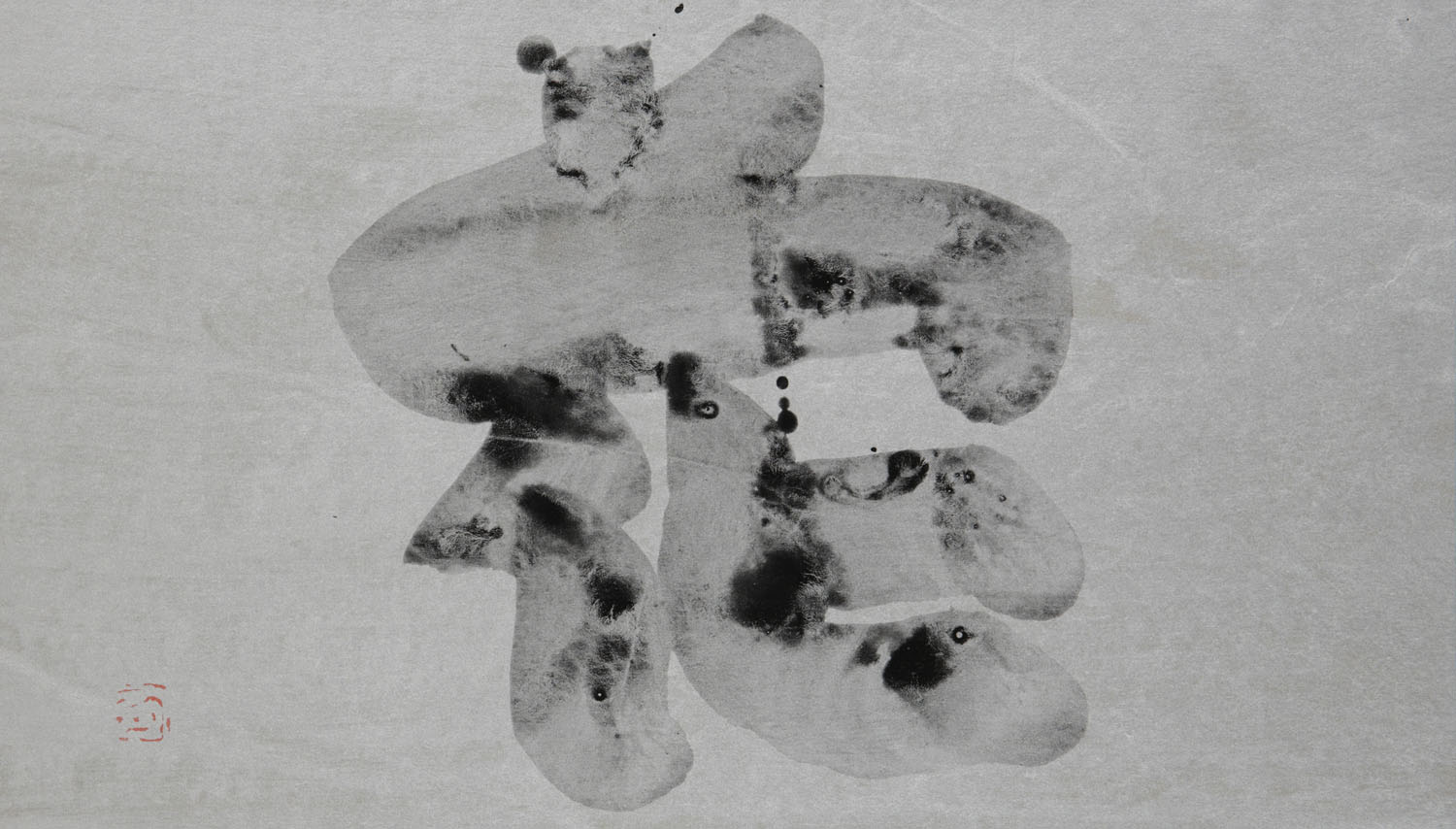
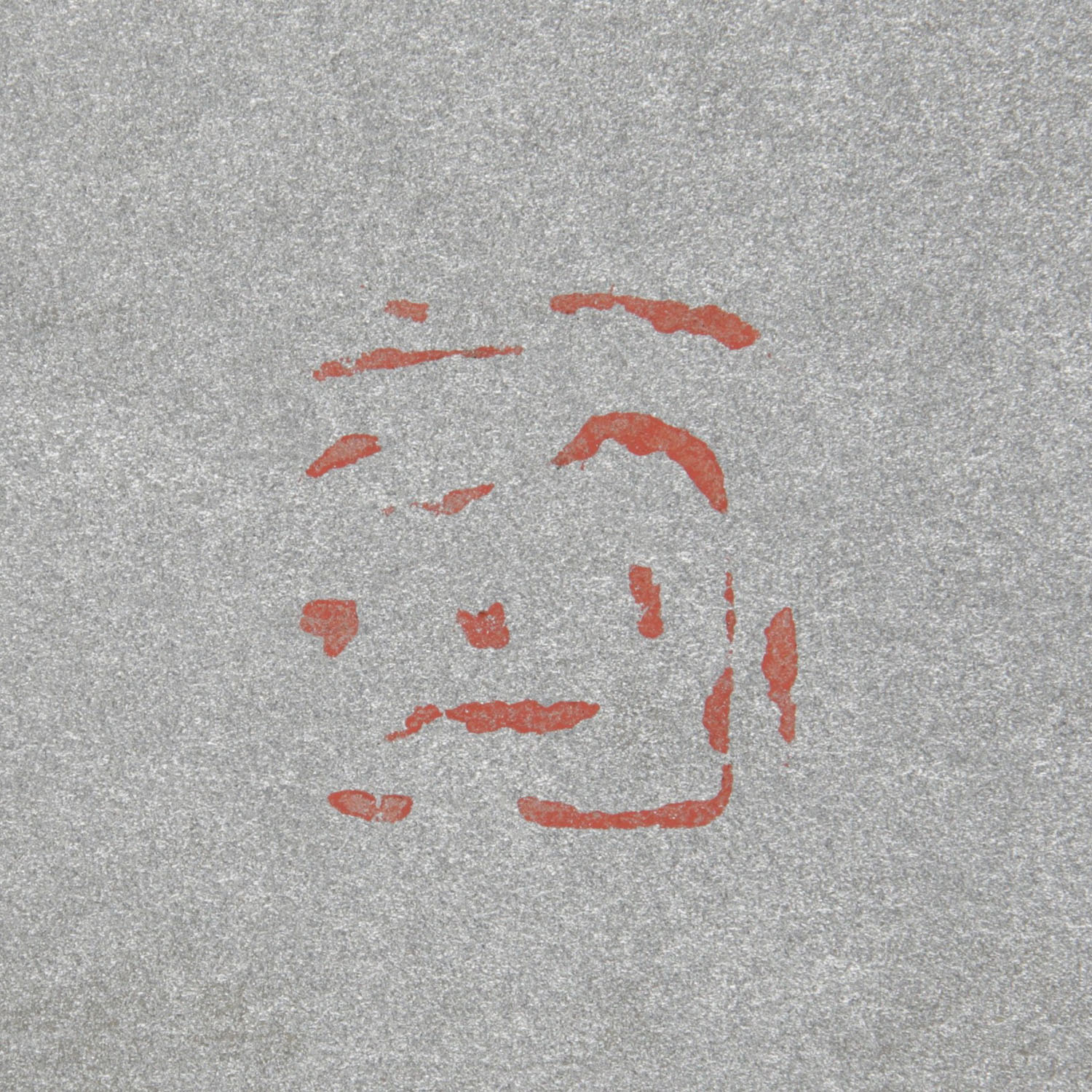
Inoue Yūichi
1916-1985
Hana (flower)
1981
Ink on silver-ground paper, framed
Sealed "yū" on the lower-right
With a label issued by
Unagami Masoimi of Unac Tokyo
35 × 60 cm
Exhibition
First-time Showing 26-1. Tokyo:
Unac Tokyo, 1993
Publication
Unagami Masaomi
ed. Yu-ichi [Yu-ichi INOUE]:
Catalogue Raisonné of the works
1949-1985. Vol.1 Tokyo:
Unac Tokyo, 1998.
Catalogue raisonné no. 65019
Avant-garde calligrapher from Tokyo. Inoue studied calligraphy under Ueda Sōkyū, an avant-garde calligrapher who also mentored Morita Shiryū. Inoue co-founded the calligraphers’ group Bokujinkai. His large-scale, experimental calligraphy of single Chinese characters resonated strongly with the concurrent movement of Abstract Expressionism and breathed new life into the calligraphy world in Japan. Regarded as daring and innovative, his works were widely exhibited in Japan and abroad, including Documenta 2 in Kassel (1959) and the São Paulo Biennial (1957, 1961).
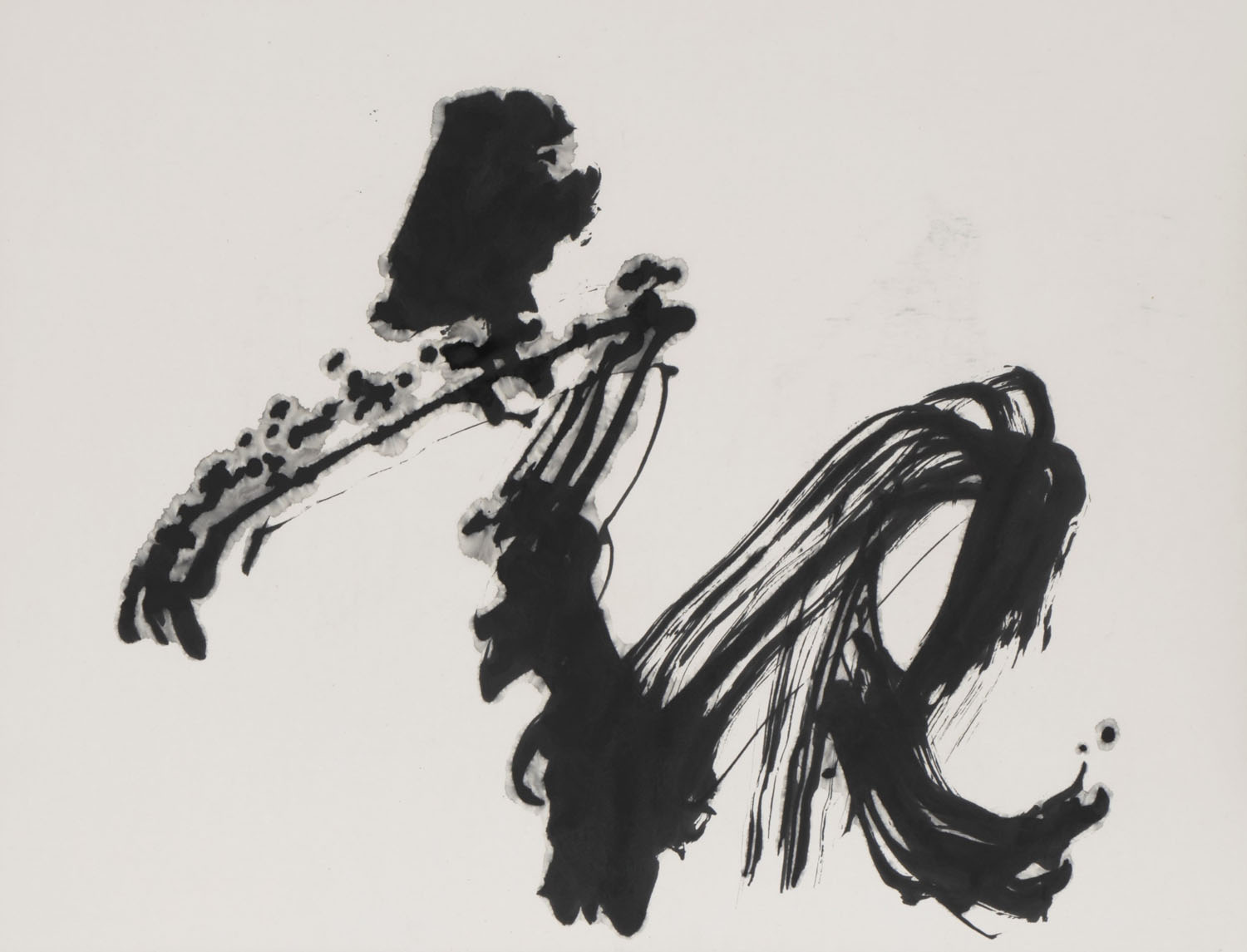
Morita Shiryū
1912-1998
Kan (insight; seeing clearly, having clear perspective, visualizing [Buddhas or Pure Land])
c. 1964
Ink on paper, framed
With a label issued by Inada Sousai of
Bokujinkai and Soryusha
69.5 × 90.5 cm
Publication
Inada Sousai ed. Morita Shiryū Catalogu
Raisonné: 1952-1998. Uji, Kyoto:
Soryusha, 2019.
Catalogue raisonné no. XVII-011
Avant-garde calligrapher from Hyōgo Prefecture. Like fellow artist Inoue Yūichi, Morita studied under the calligraphy master Ueda Sōkyū. He co-founded the avant-garde group Bokujinkai together with Inoue and was the founder and editor of the journal Bokubi (Beauty of Ink), both of which revolutionized traditional Japanese calligraphy and spread knowledge of Japanese avant-garde calligraphy to an international audience. He was posthumously awarded the Medal of Honor with Dark Blue Ribbon.

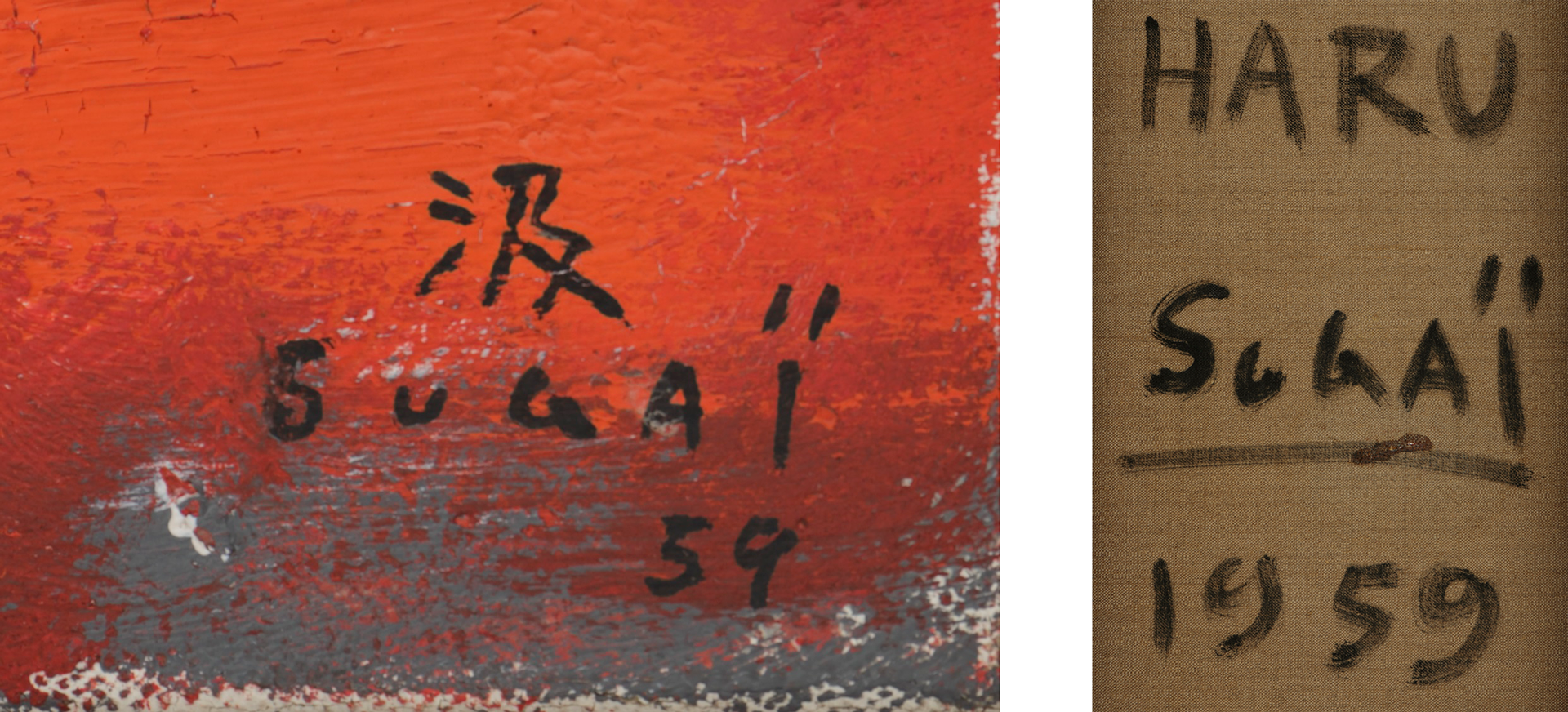
Sugaï Kumi
1919-1996
Haru
1959
Oil on canvas, framed
Titled, dated, and signed on the front and the reverse respectively
195 x 30.2 cm
Painter from Kobe. Sugaï dropped out of Osaka College of Art to work as a commercial designer while studying privately with Yoshihara Jirō of the Gutai group. In 1952, he moved to France and continued to live and work in Paris. His style shifted from his early works, with emphasis on distinctive brushwork, to a new ‘flat’ approach resembling signs and symbols. Sugaï was among the first postwar Japanese painters to achieve international acclaim.
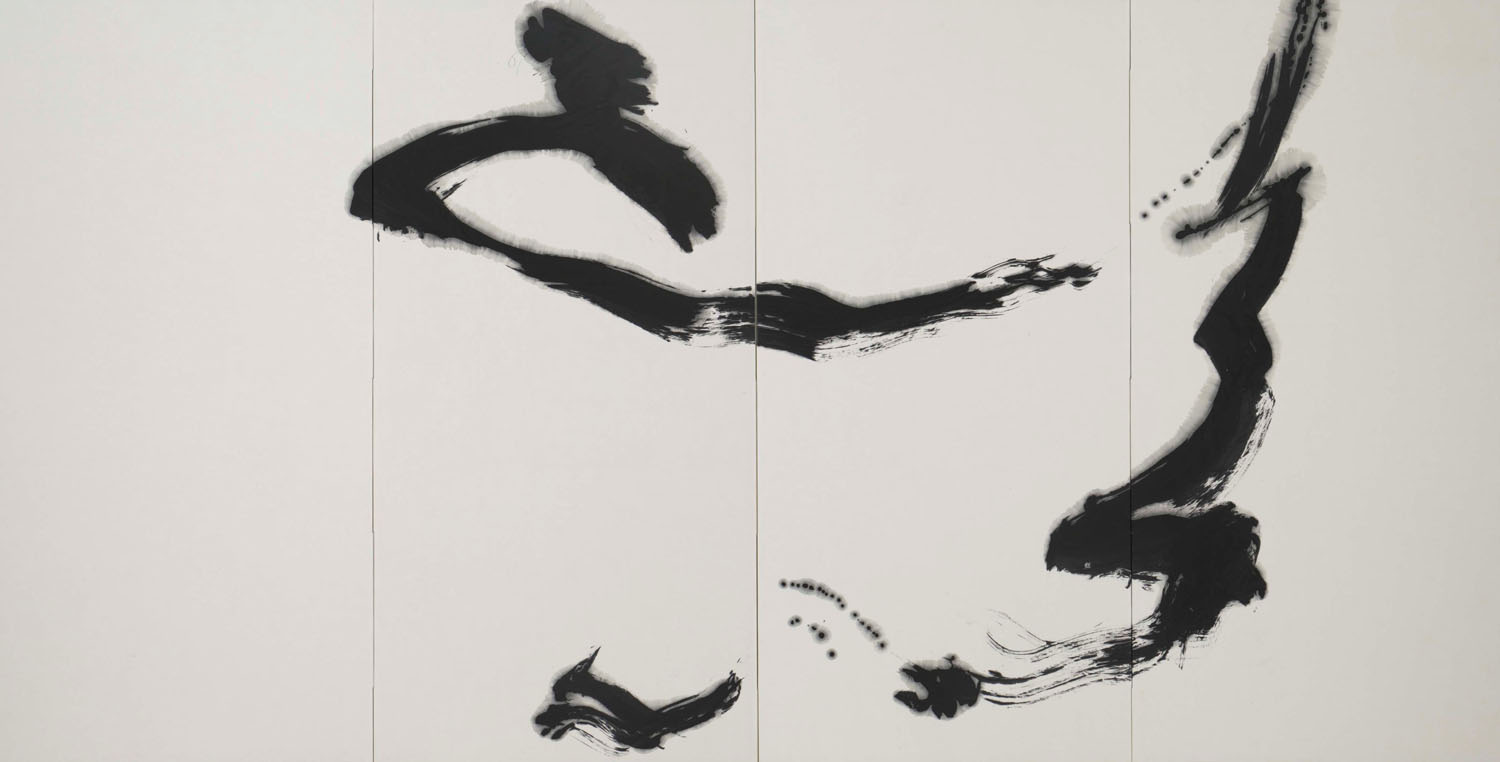
Morita Shiryū
1912-1998
Kumo-mushin
(the cloud is egoless;
like drifting coulds
we should live spontaneously)
c. 1967
Ink on paper, four-panel
folding screen
With a label issued by Inada
Sousai of Bokujinkai and Soryusha
137 × 276 cm
Publication
Inada Sousai ed. Morita Shiryū
Catalogue Raisonné: 1952-1998.
Uji, Kyoto: Soryusha, 2019.
Catalogue Raisonné no.XVI-862"
Avant-garde calligrapher from Hyōgo Prefecture. Like fellow artist Inoue Yūichi, Morita studied under the calligraphy master Ueda Sōkyū. He co-founded the avant-garde group Bokujinkai together with Inoue and was the founder and editor of the journal Bokubi (Beauty of Ink), both of which revolutionized traditional Japanese calligraphy and spread knowledge of Japanese avant-garde calligraphy to an international audience. He was posthumously awarded the Medal of Honor with Dark Blue Ribbon.
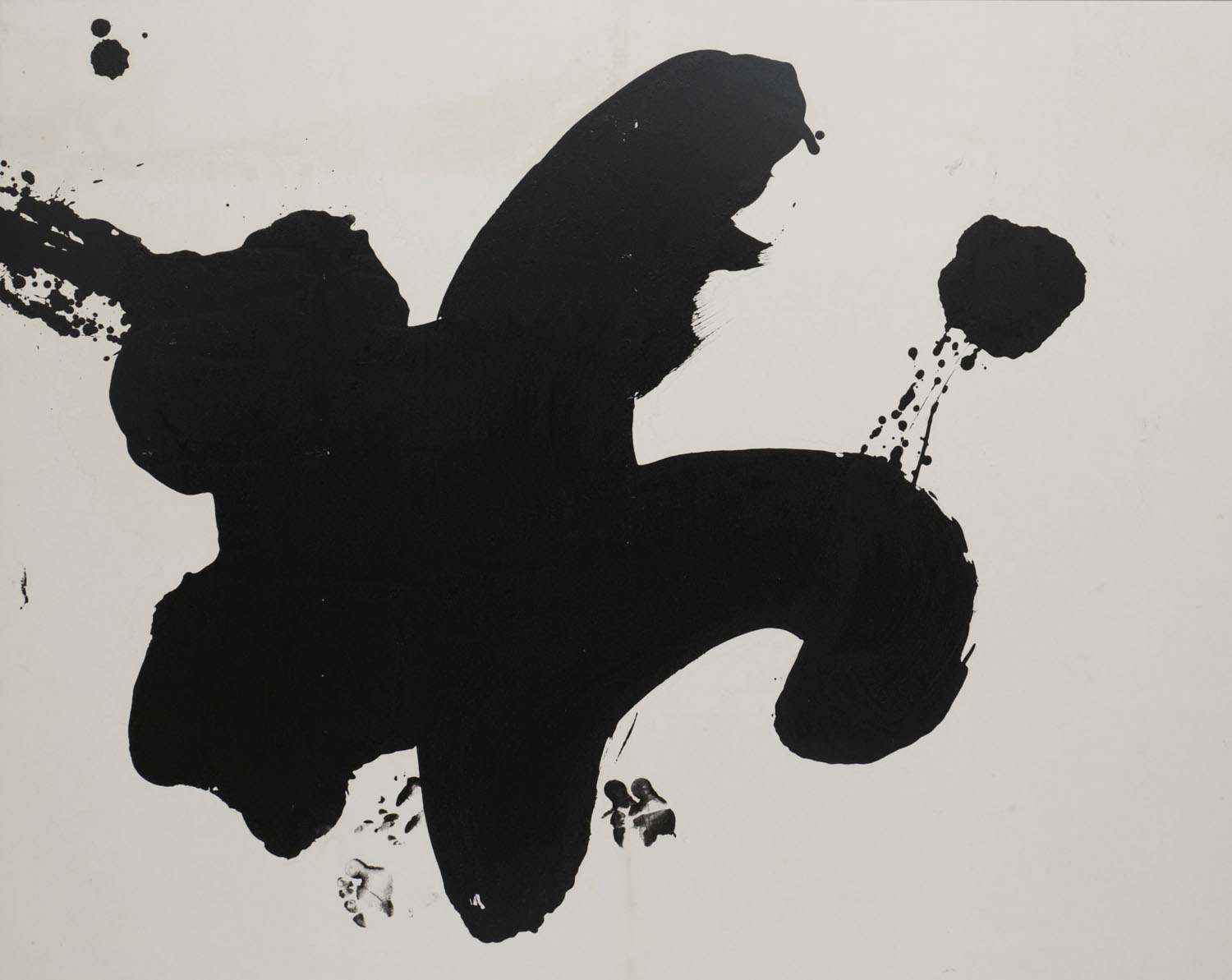
Morita Shiryū
1912-1998
Ki (tree; our beings form our sho,
just as the history of
a tree determines its shape)
1995
Ink on paper, framed
With a label issued by Inada Sousai
of Bokujinkai and Soryusha
140 × 176 cm
Publication
Inada Sousai ed. Morita Shiryū
Catalogue Raisonné: 1952-1998.
Uji, Kyoto: Soryusha, 2019.
Catalogue Raisonné no.XVII-207
Avant-garde calligrapher from Hyōgo Prefecture. Like fellow artist Inoue Yūichi, Morita studied under the calligraphy master Ueda Sōkyū. He co-founded the avant-garde group Bokujinkai together with Inoue and was the founder and editor of the journal Bokubi (Beauty of Ink), both of which revolutionized traditional Japanese calligraphy and spread knowledge of Japanese avant-garde calligraphy to an international audience. He was posthumously awarded the Medal of Honor with Dark Blue Ribbon.
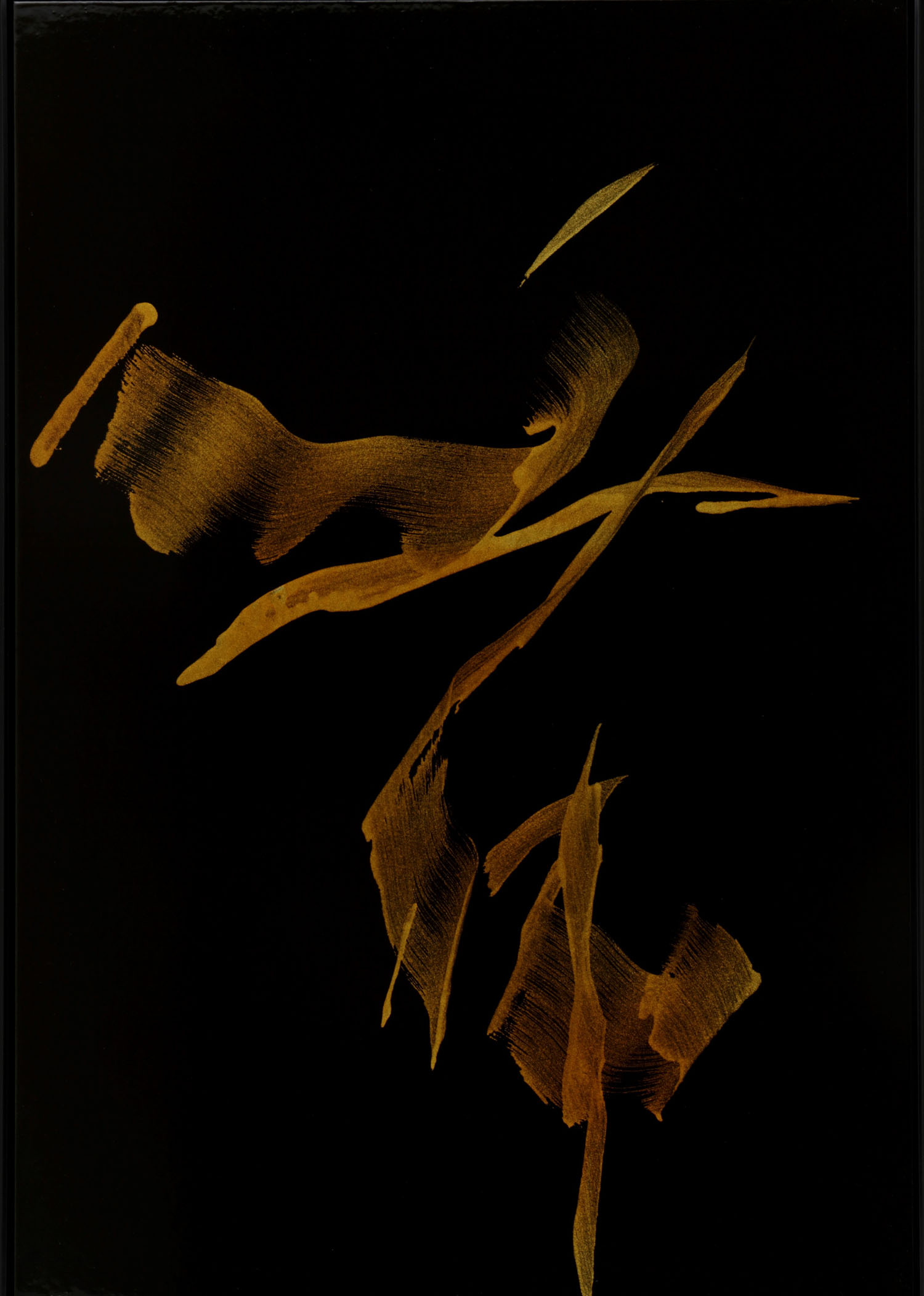
Morita Shiryū
1912-1998
Mau (dancing, soaring;
true motion is poetic)
c. 1969
Aluminum flake pigment and
lacquer on paper, framed
With a label issued by Inada Sousai of
Bokujinkai and Soryusha
78.5 x 54 cm
Publication
Inada Sousai ed. Morita Shiryū
Catalogue Raisonné: 1952-1998.
Uji, Kyoto: Soryusha, 2019.
Catalogue raisonné no. XVI-754"
Avant-garde calligrapher from Hyōgo Prefecture. Like fellow artist Inoue Yūichi, Morita studied under the calligraphy master Ueda Sōkyū. He co-founded the avant-garde group Bokujinkai together with Inoue and was the founder and editor of the journal Bokubi (Beauty of Ink), both of which revolutionized traditional Japanese calligraphy and spread knowledge of Japanese avant-garde calligraphy to an international audience. He was posthumously awarded the Medal of Honor with Dark Blue Ribbon.
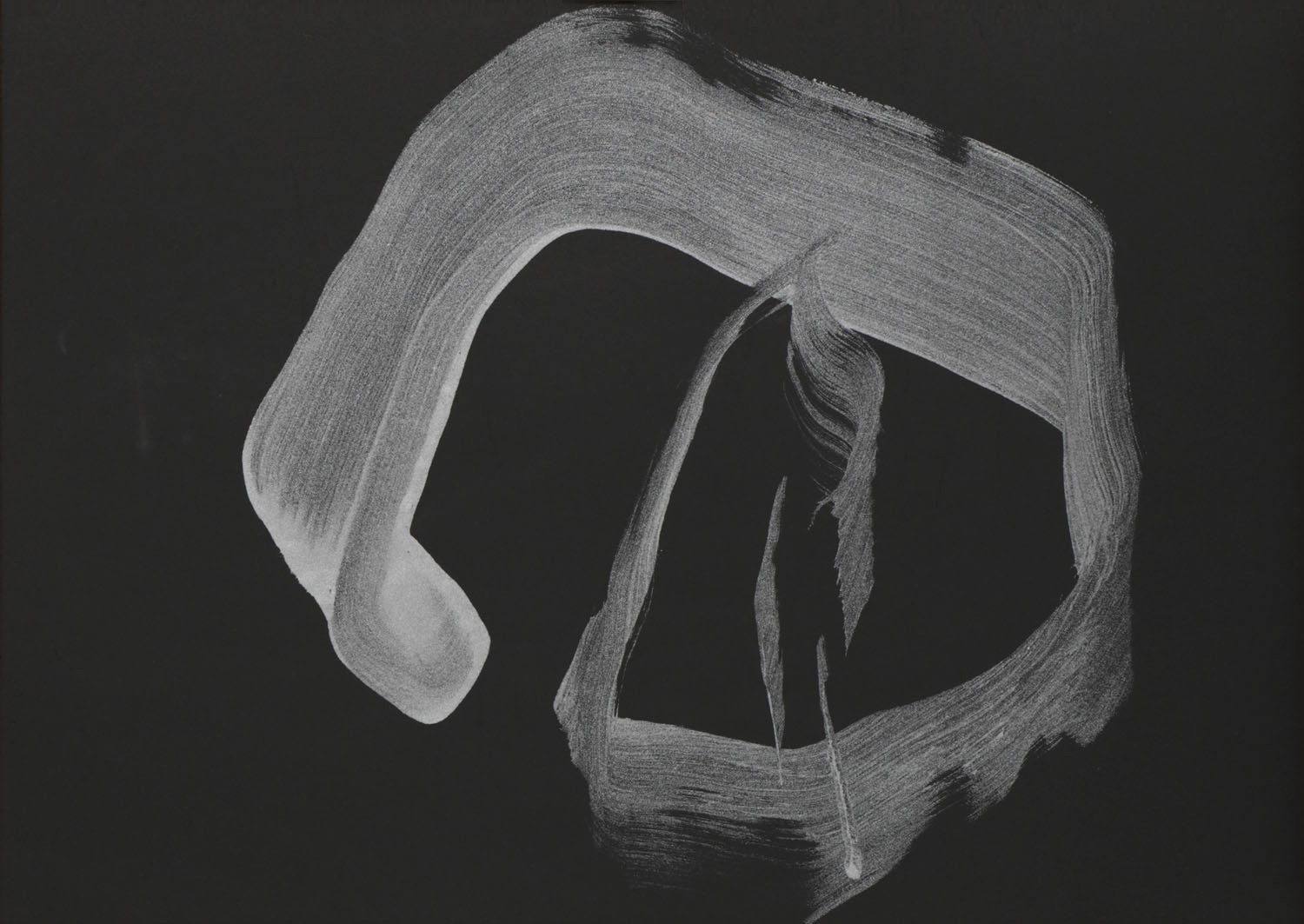
Morita Shiryū
1912-1998
En (circle, or symbol of the perfection of being)
c. 1969
Aluminum flake pigment on paper, framed
With a label issued by Inada Sousai of
Bokujinkai and Soryusha
53 × 74 cm
Publication
Inada Sousai ed. Morita Shiryū
Catalogue Raisonné: 1952-1998.
Uji, Kyoto: Soryusha, 2019.
Catalogue Raisonné no.XVI-865
Avant-garde calligrapher from Hyōgo Prefecture. Like fellow artist Inoue Yūichi, Morita studied under the calligraphy master Ueda Sōkyū. He co-founded the avant-garde group Bokujinkai together with Inoue and was the founder and editor of the journal Bokubi (Beauty of Ink), both of which revolutionized traditional Japanese calligraphy and spread knowledge of Japanese avant-garde calligraphy to an international audience. He was posthumously awarded the Medal of Honor with Dark Blue Ribbon.
